How to Wear a White Collar Dress Shirt
The Dress Shirt is a Foundation of Your Outfit
Dress shirts are one of the most ubiquitous and important articles in menswear. They provide a central point of interest around which the rest of your outfit is built and also play an important role in framing your physical appearance and contributing to your physical comfort.
Therefore, it is critically important that you find a dress shirt that complements your personal style, body, and wardrobe. There are, however, a shocking number of styling options for men's dress shirts. On the one hand, this reality should enable every man to find a great fit and style that works for his needs, but on the other, it can be daunting to wade through all the details.
You need not worry, however, because this guide will provide you with all of the information that you need to not only select a dress shirt that looks and feels great but to also build a collection of dress shirts that will be the perfect focal points for countless stylish outfits.
What a Dress Shirt Is

At its most fundamental level, a dress shirt, also known as a day buttoned shirt, is a garment that features a collar and full-length opening fastened with buttons or studs.
Traditionally, this shirt was effectively an undergarment, always being worn beneath a waistcoat and jacket. Nowadays, dress shirts can be worn without additional garments, although within the Classic Style, it is still conventional to see dress shirts usually paired with jackets.
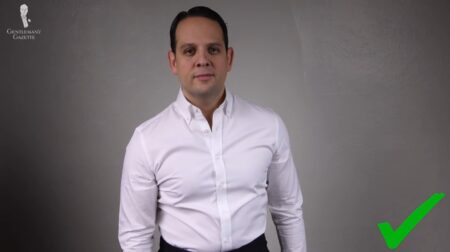
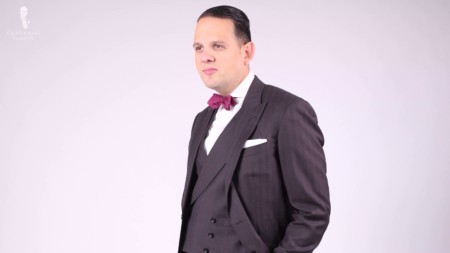
Different Dress Shirts Serve Different Functions
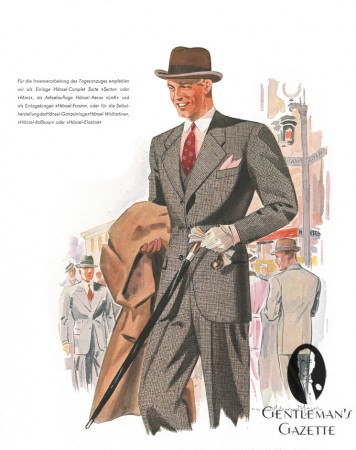
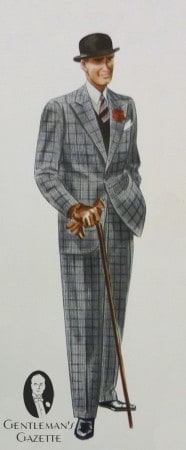
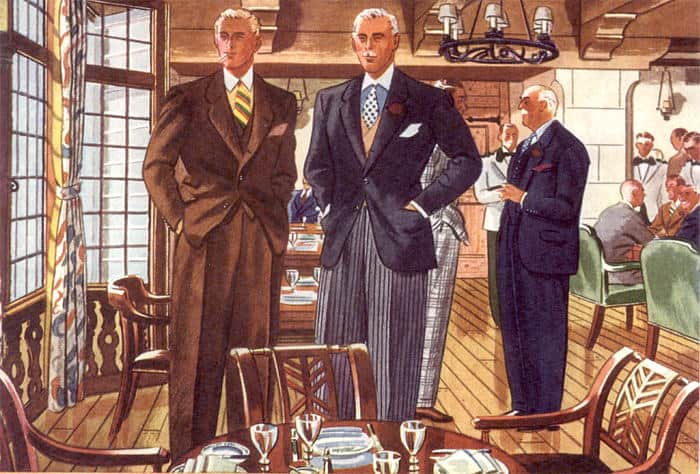
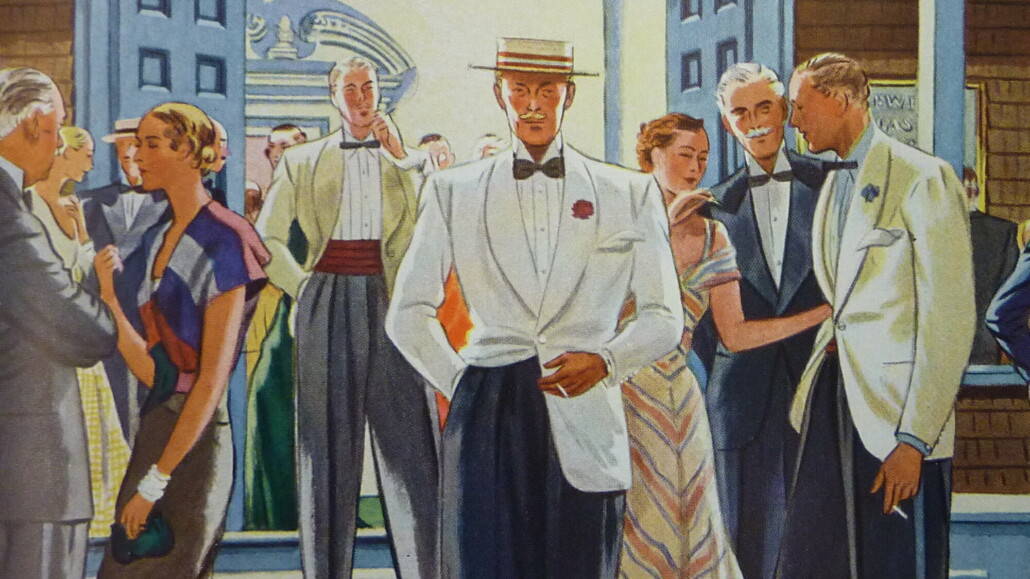
Because dress shirts are available in a wide variety of styles, colors, and cuts, they can vary greatly as regards the situations or occasions for which they are appropriate. A pink and white striped dress shirt might be the perfect complement to a summer suit while on vacation in Italy, but it would not be appropriate in a professional office setting, like a law firm.
Certain dress shirts and dress shirt features can even be expressly reserved for very particular shirt occasions and dress codes. Two obvious examples are the Black-Tie Evening Shirt and the White-Tie Evening Shirt, which are sometimes, confusingly enough, referred to as "Full-Dress" shirts.
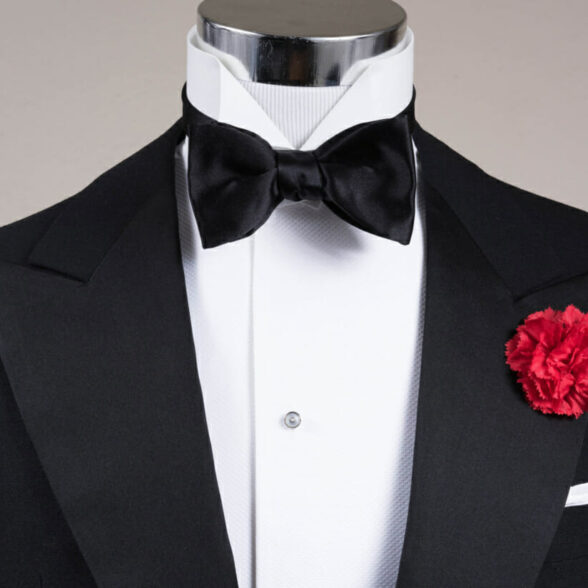
What Makes a …
Black-Tie Shirt
- Also called a "Tuxedo" or "Smoking" Shirt
- Constructed of white cotton in a solid or micropattern
- Soft turndown collar with a classic spread
- Pleated or pique front bib
- Soft french cuffs
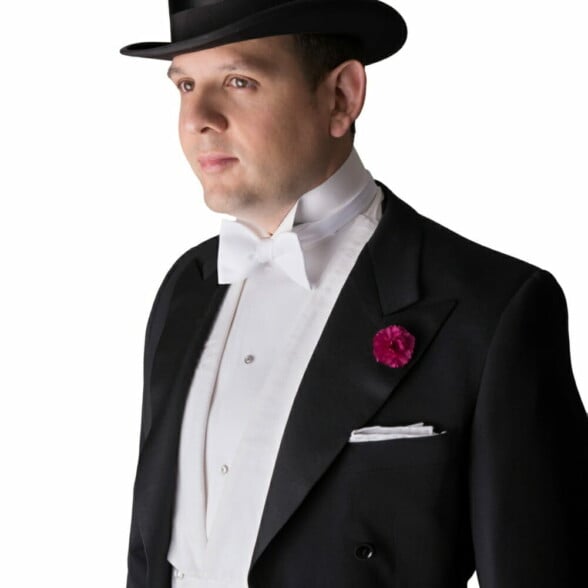
What makes a …
White-Tie Shirt
- Constructed of white cotton, usually broadcloth or voile
- Detachable stiff wing collar
- Stiff single cuffs
- Cotton pique, plain cotton, or linen stiff bib front
Assessing Dress Shirt Formality
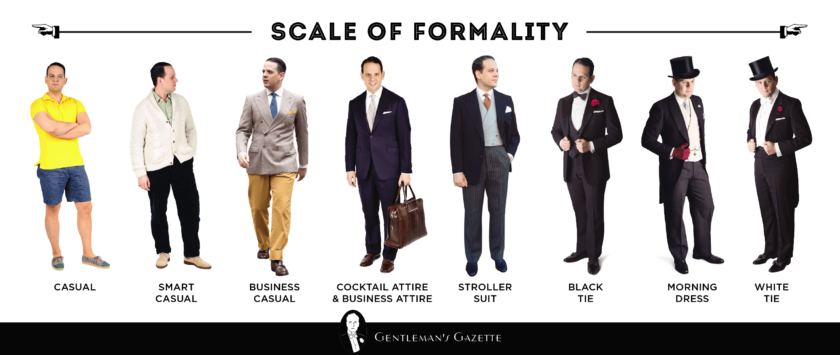
Dress shirts can range in formality from the very casual to the extremely formal. In general, how casual or formal a dress shirt is depends upon the cumulative total of the relative formality of its parts.
Said another way, the inclusion of certain features that are either very formal or very casual can skew the overall formality of the entire shirt. All of the major features of a dress shirt will be discussed in the following guide, with information about the relative formality of these features. With this information, you will be able to determine, by looking at the shirt as a whole, how casual or formal it is.

"I'm so sorry, Thomas has lost all of my dress shirts."
Robert Crawley in Downton Abbey
For more on this concept, be sure to study our guide to the Formality Scale.
What a Dress Shirt Is Not


There are a great number of shirts in existence, and only some of them qualify as dress shirts. Any shirt that does not satisfy the above definition – a shirt that features a collar and full-length opening fastened with buttons or stands – is not a dress shirt.
Therefore, tee shirts, polo shirts, henley shirts, and the like are not dress shirts.
Conversely, some collared shirts with full-length buttoned openings do not function stylistically as dress shirts, and therefore are not included. These primarily include shirts that would traditionally not be worn with a jacket and were often worn without neckwear.
These include sport shirts, which are essentially very casual dress shirts, and work shirts, which are designed to be functional rather than fashionable garments. These shirts are often distinguished by their materials, which tend to be hardwearing fabrics like denim or flannel.
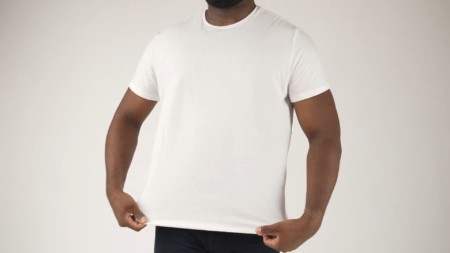
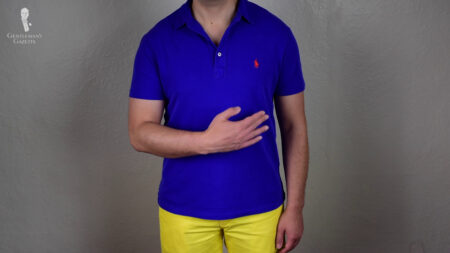
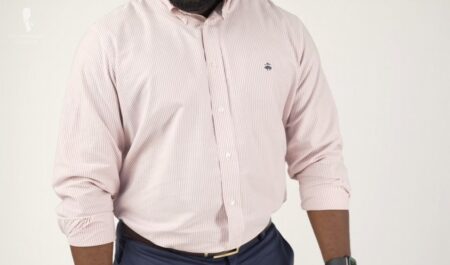
Determining Your Dress Shirt Size
Most off-the-rack dress shirts are sized according to the circumference of your neck and the length of your arm. These two measurements will often be expressed together, such as 16 & 32, the former being the neck circumference and the latter the length of the arm.
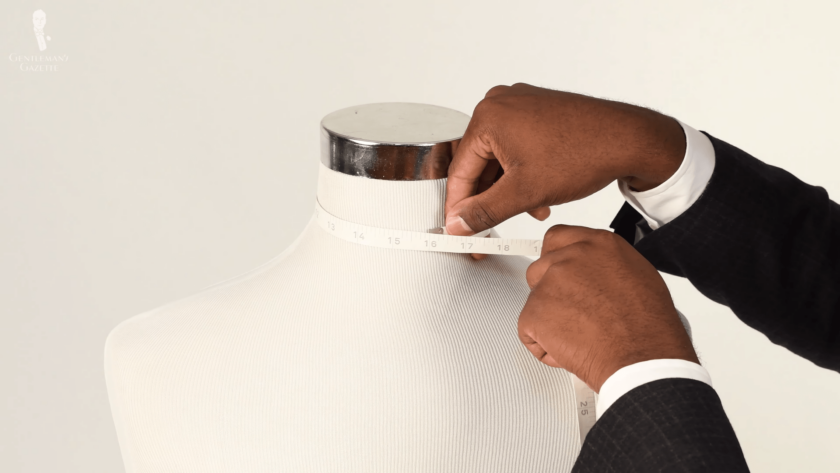
Off-the-rack dress shirt makers utilize these measurements because they are the most important measurements to ensure a decent fit for most gentlemen. Additional measurements, such as chest circumference or hem length, are calculated as a ratio of the two provided measurements.
Be wary of any dress shirt maker that employs more generic measuring standards, such as "Small, Medium, and Large" sizing. Arm length and neck size vary greatly from gentleman to gentleman, and it is very unlikely that any dress shirt that does not take at least these measurements into consideration will offer a good fit.
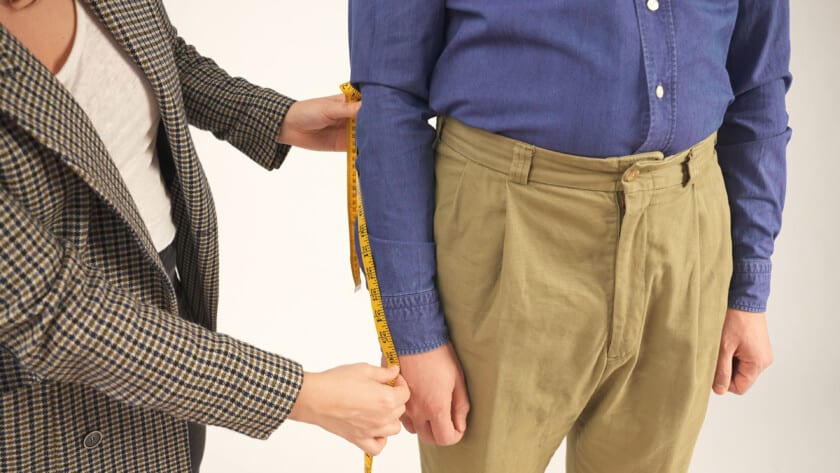
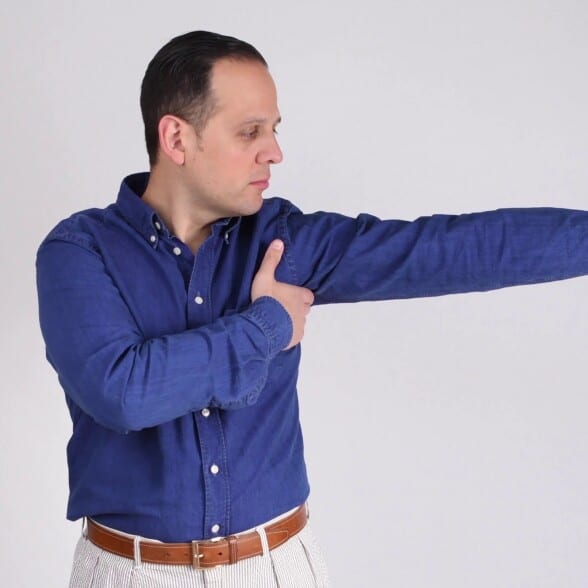
Be sure to measure both of your arms!
Few portions of the human anatomy are completely proportional, so your arms will likely be of different lengths. Most gentlemen provide the measurement of the longer of their two arms, as a slightly longer sleeve is usually less noticeable than a slightly shorter sleeve. For made-to-measure shirts, you will have the opportunity to provide the length of each arm individually, ensuring the perfect fit for both arms.
Made-to-Measure and Bespoke Shirts
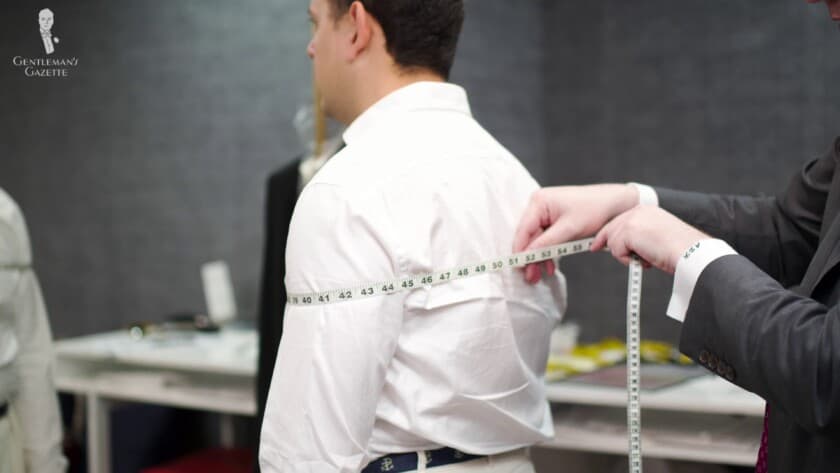
A made-to-measure or bespoke shirt will be speficialy prepared to your exact measurements. Such a shirt will naturally require additional sizing information. In addition to neck size and arm length, you will likely also have to provide chest, waist, and wrist circumference, as well as the length of your shoulders and back.
The inclusion of this information will result in a dress shirt that offers a much better, more tailored fit, but at a proportional increase in overall cost.
Learn more about Bespoke, MTM, & MTO
Understanding the Different Dress Shirt Fits
What "Fit" Means in this Context
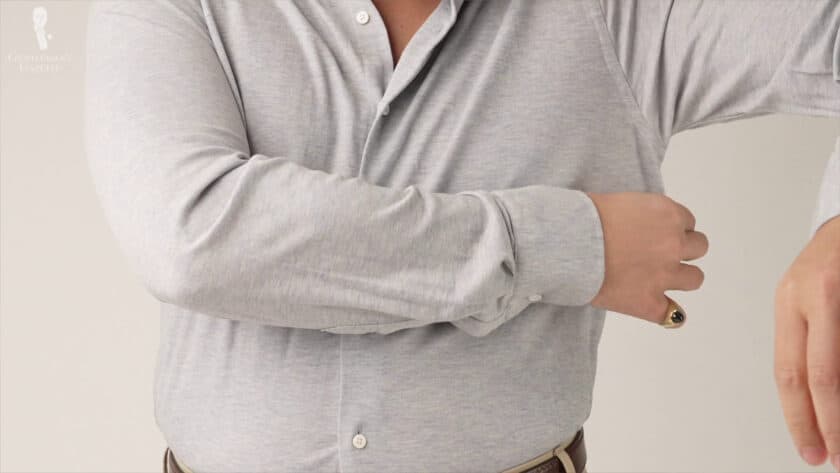
Your measurements provide a baseline for the general sizing of your dress shirt, but there is considerable leeway in how those measurements are used to create the finished dress shirt. This leeway is generally referred to as "fit."
Consider, for instance, that if a dress shirt sleeve length were cut exactly to the length of your arm, it would sit very tightly against your skin and roll up or down depending on your arm movement. Therefore, tailors add in a certain amount of excess fabric to accommodate movement, as well your personal comfort and overall style.
How much additional fabric is employed is the central component of the conventional fits for a dress shirt, which vary according to styling, comfort, and your own body shape. Arguably fit is the most striking and important feature of a shirt; if your shirt is ill-fitting, none of the details will matter.
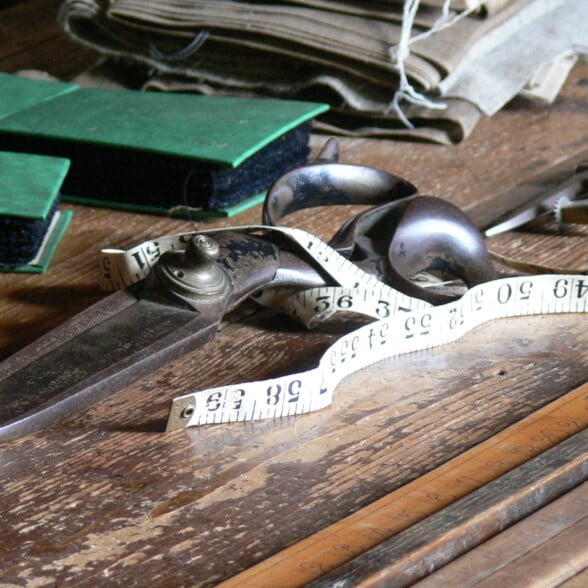
An important note on
Alterations
Before getting started, it is important to note that unlike other garments like jackets and trousers, achieving a good fit with a dress shirt is best accomplished by purchasing the right shirt from the outset. Alterations are pricey relative to the cost of a shirt, so if you have fit challenges, it's best to have your shirts produced made-to-measure or bespoke. These options are far less expensive for shirts, so even men with modest budgets will find a shirt manufacturer in their budget range.
Classic Fit
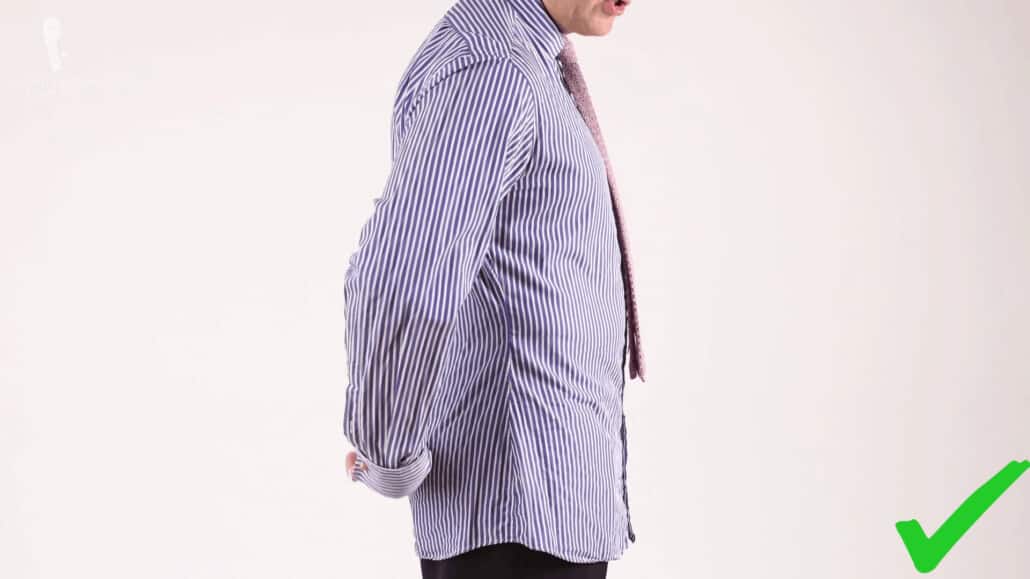
The classic fit is likely what your father and grandfather wore. It is characterized by a traditional tailoring silhouette, allowing a comfortable fit with a boxier shape, with plenty of fabric in the sleeves and the body. It provides great mobility and features two pleats on the back, usually located near the yoke.
Since men in the mid-20th century would never wear a shirt without a jacket, or even a waistcoat, the main priority was comfort. This is the go-to choice for those with a more classic style who favor comfort over fashion.
If you regularly wear shirts with a jacket, this is probably the best fit for you because it is the most comfortable. It can be overwhelming on thinner frames, but if you have a rounder stomach, this is the most comfortable and most flattering style for your body shape.
Slim Fit
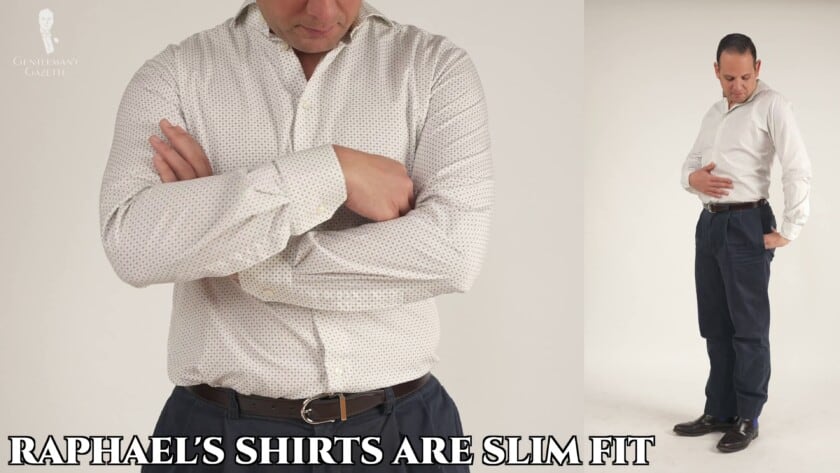
Throughout history, young men have often tried to differentiate their look from their parent's generation. At the same time, it has become socially acceptable to wear a dress shirt without a jacket, and therefore the look and fit of the shirt itself has become more important.
While a slim fit shirt is less comfortable and often more constricting in your movement, it is a lot more fashionable because it eliminates excess fabric. A slim fit shirt typically has an accentuated back with darts and a high armhole stance allowing for a shaped look that sits closer to the body, without being skin tight.
When carefully tailored, a slim-fit shirt can look flattering on all frames, but heavier gentlemen are advised to avoid off-the-rack slim fits, which are invariably constricting.
Modern Fit
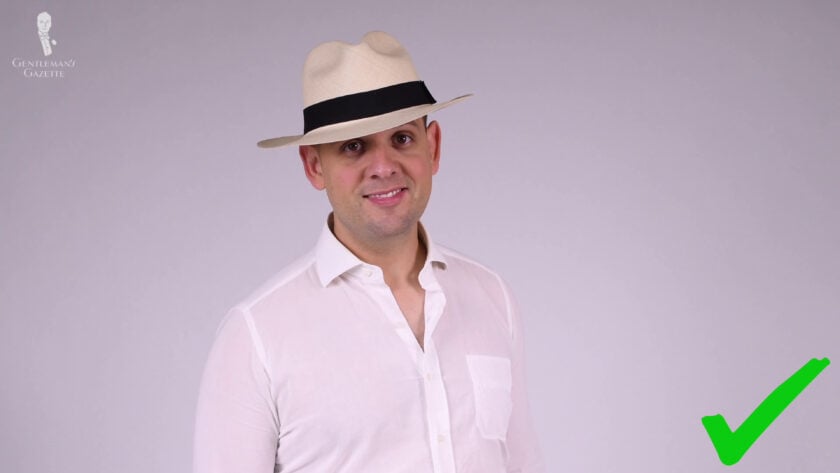
The modern fit falls in between the classic and the slim fit, potentially providing the best of both worlds when it comes to comfort and style. It features a slightly tapered silhouette at the waist, sometimes in combination with small back darts create a trimmer look than the classic fit that looks good even without a jacket without sacrificing comfort. The armholes are high, the sleeves have some room but are not too wide, and the yoke extends to or just past the shoulder bone.
This fit will complement all but the largest of frames.
Super Slim
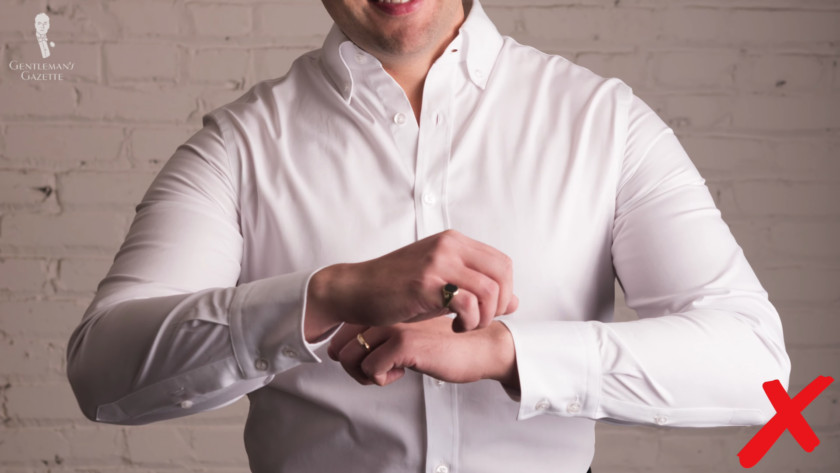
This super slim or skinny fit is mostly popular with young men who think that tighter is better. In practice, this fit is usually characterized by lots of wrinkles, and unless you have a very skinny body that justifies it, you should avoid it altogether. Skintight shirts are not a flattering alternative for anyone, and they restrict your range of movement considerably. If you are interested in Classic men's style, Super Slim is not considered part of the Classic Canon.
Determining the Fit that is Right for You
No matter what option you choose, fit will have a huge impact on the overall look of your dress shirt, and by extension, the entire outfit. People often talk about the "perfect fit" as if it was one objective standard, but in fact, it contains many subjective elements that rely heavily on your personal style and body type. Ultimately, the "right fit" is "whichever fit is right for you."
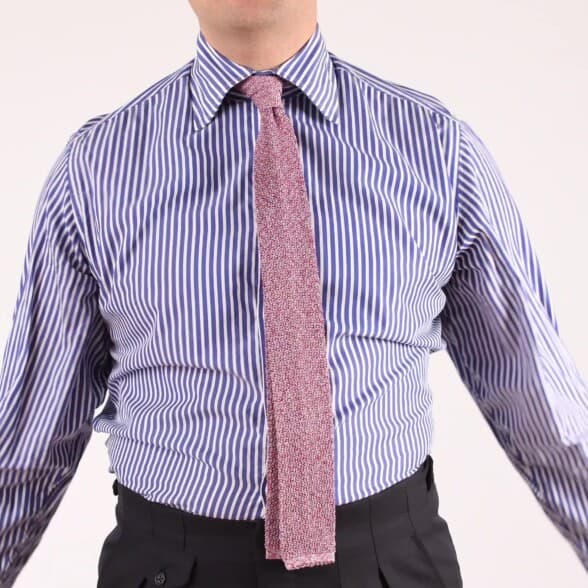
What's in a name?
While many modern shirt makers employ somewhat standardized nomenclature when referring to shirt fits, there is no standard as to what "Slim" or "Modern" actually means. Therefore, consult individual fit guides or speak with a sales representative to determine fit specifications. Likewise, some makers use more florid language when designating fits. American shirtmaker Brooks Brothers, for instance, calls their slim fit "Milano" and their traditional fit "Madison." Consult the attendant fit guide to unravel exactly what type of fit these names designate.
Finding the Right Material for You
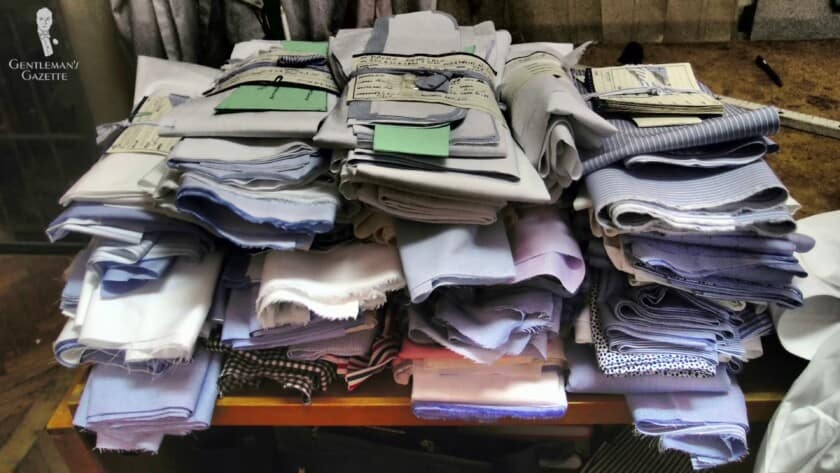
The topic of shirt material has already been converted extensively in a dedicated Material & Fabric guide. Below, however, you can find a summation of some of its most important points.
| Material | Notes |
|---|---|
| Cotton | Lightweight and breathable, cotton is the favored material for most dress shirts. Because cotton comes in a wide variety of weaves, it can be adapted to suit a variety of climates and situations. Learn more in our dedicated Guide to Cotton. |
| Linen | One of the oldest fabrics in existence, linen is a lightweight material renowned for its breathability and its unique ability to wrinkle in delicate, pleasing folds. Linen is favored as a shirt fabric in warm and hot weather climates and can make an excellent seasonable option. Learn more in our dedicated Guide to Linen. |
| Silk | Silk has been treasured as a luxury fabric for millennia, and it remains a popular option for high-end shirts to this day. In addition to the aesthetic appeal of its unique sheen, silk has unique insulating properties that help keep you cool when it's hot and warm when it's cold. Be advised, however, that genuine silk has a sizable price tag. |
| Synthetics | Throughout the 20th and 21st centuries, scientific advancements have produced a cavalcade of "new and improved" fabrics that claim to feature improved comfort, wearability, wrinkle resistance, moisture-wicking, and countless other benefits. In our experience, however, these so-called "performance fabrics" always have drawbacks and have never managed to genuinely out-perform natural fibers. |
The Impact of Colors, Patterns, and Weaves
Colors
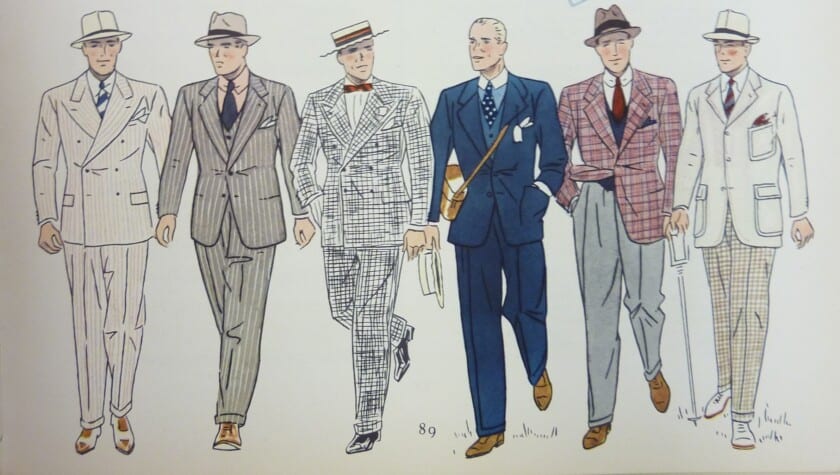
Dress shirts can literally come in any color, although the relative formality of those colors will often dictate which hues are appropriate for different occasions. Certain colors are also better-suited to particular seasons or climates.
Understanding color theory will allow you to integrate your dress shirt color perfectly into any outfit, but in menswear, the most common shirt colors you will encounter are white, off-white, and blue.
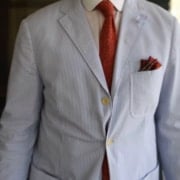
White
The white dress shirt has been the traditional dress shirt option for centuries and remains the most common color for dress shirts today. A white shirt can be paired with almost anything, and its neutral appearance will not only complement but highlight all of your outfit's other elements.
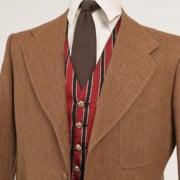
Off-White
Because the white dress shirt can often come off as somewhat cold, the off-white dress shirt offers a similar color option with more warmth and visual interest. Off-white dress shirts can pair with most of the colors that can be paired with white, but is best set off by earth tones, blues, and warm colors.
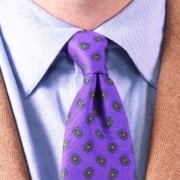
Blue
A blue shirt is the most conventional way for you to add color to your shirt collection. Nearly every shade of blue, from powder blue to navy blue, can be easily integrated into most Classic menswear outfits. It pairs especially well with gray, red, and brown.
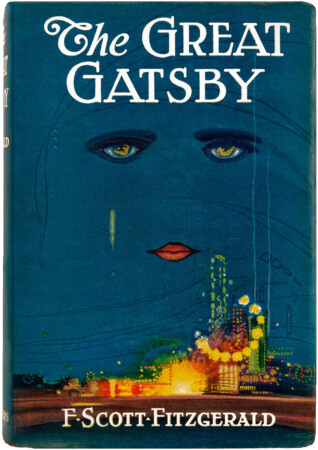
"He took out a pile of shirts and began throwing them, one by one, before us, shirts of sheer linen and thick silk and fine flannel, which lost their folds as they fell and covered the table in many-coloured disarray. While we admired he brought more and the soft rich heap mounted higher – shirts with stripes and scrolls and plaids in coral and apple-green and lavender and faint orange, with monograms of indian blue."
from The Great Gatsby by F. Scott Fitzgerald
Additional Colors
As mentioned, dress shirts can come in any color, but not every color is a good option for a dress shirt. You will be well-advised to focus on starting your dress shirt collection with the above-mentioned colors and then expanding your wardrobe to include other colors that fit in well with your larger wardrobe.
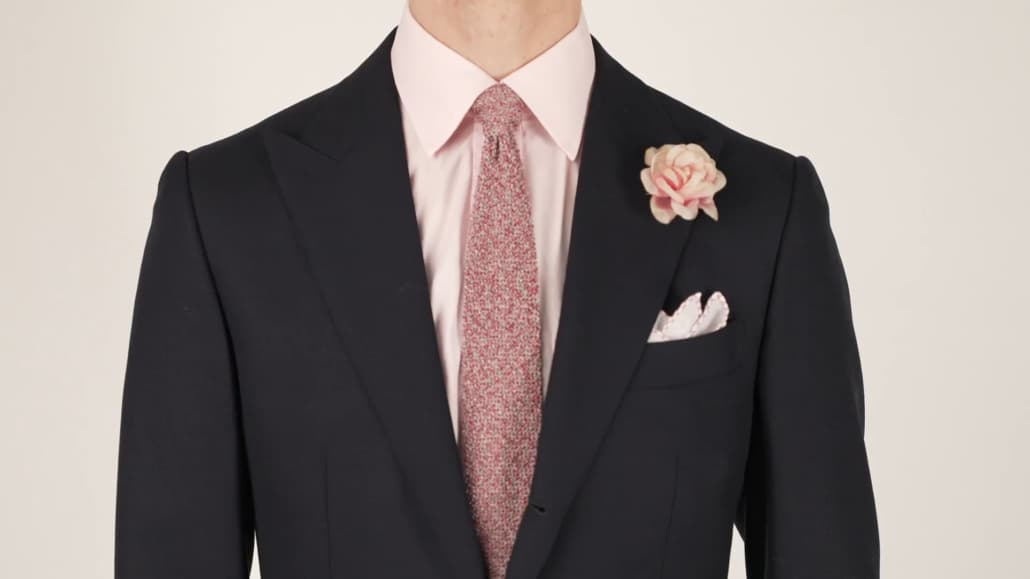
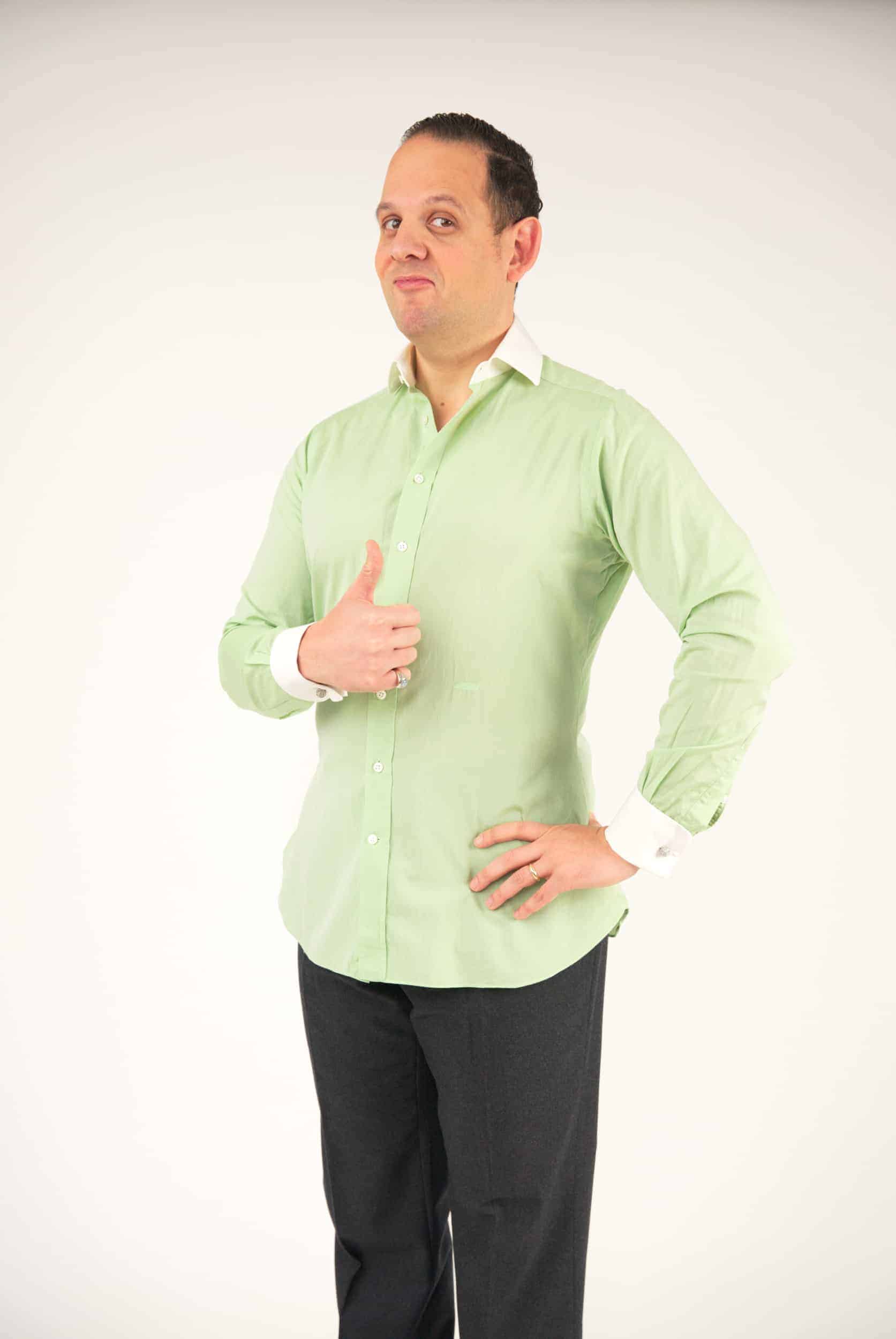
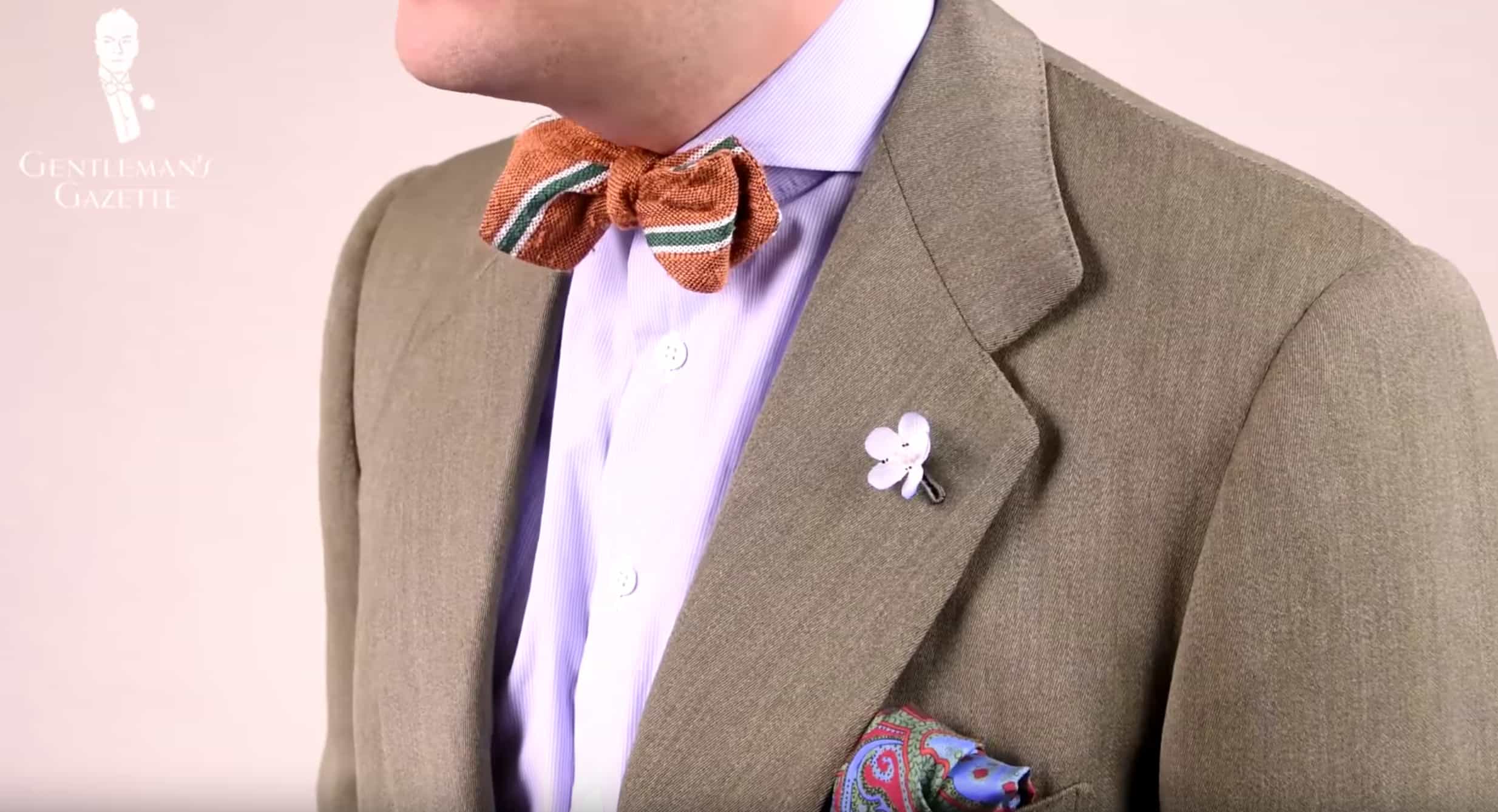
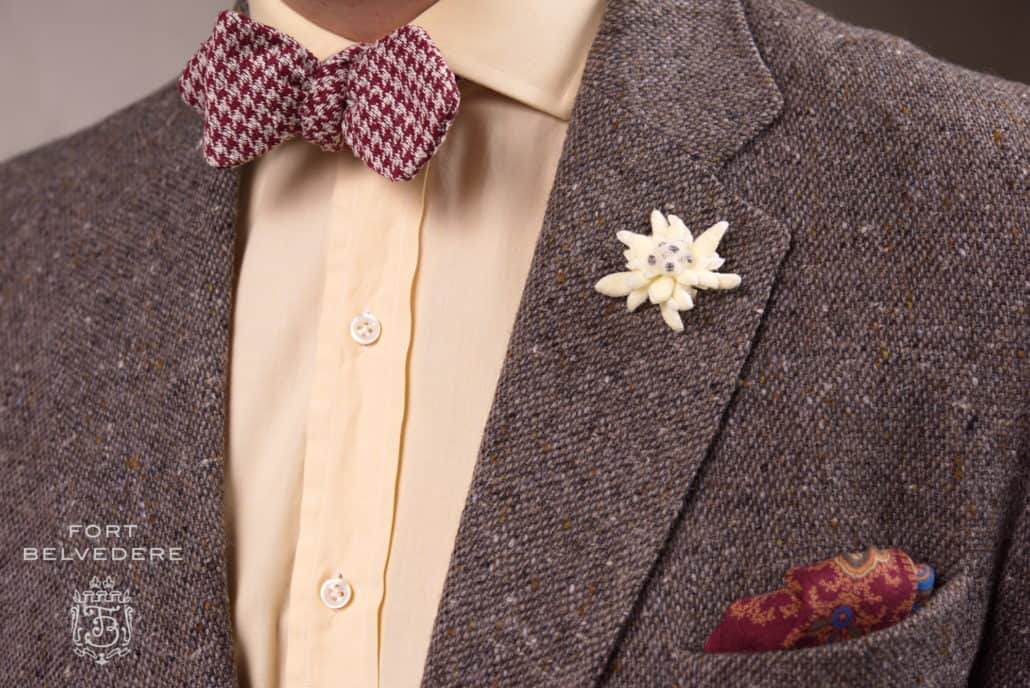
Patterns
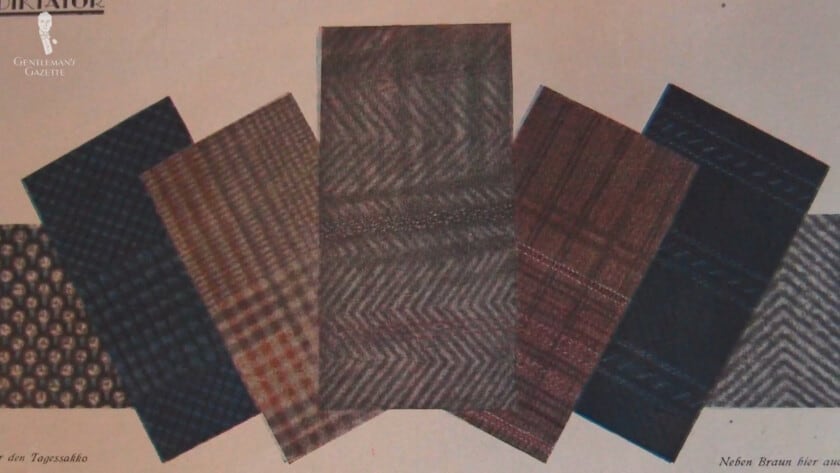
Like colors, patterns give personality and vibrancy to your dress shirts and also affect their overall formality. In general, the more complex and noticeable a pattern is, the less formal it is.
Solid

The most common pattern for a dress shirt is a simple solid color. This solid base makes it easier to match the shirt with other articles because you do not need to worry about patterns clashing. Provided that it is in a neutral color, a solid shirt is the most formal of dress shirts.
Stripes
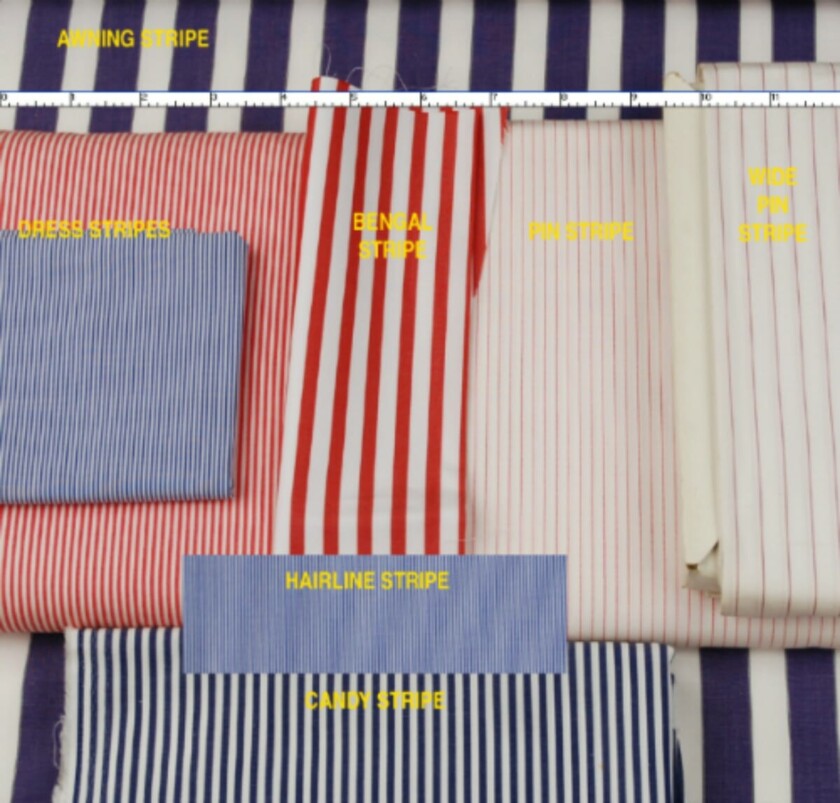
Dress shirts can feature stripes in a variety of styles, colors, and densities. The stripes are usually vertical but can also be horizontal. Striped shirts create unexpected visual interest without appearing, in most cases, overly flashy. A striped shirt is extremely versatile and can be dressed up or down depending on the other elements of your look. The color, styling, and detail of the stripe will dictate the overall formality of the shirt.
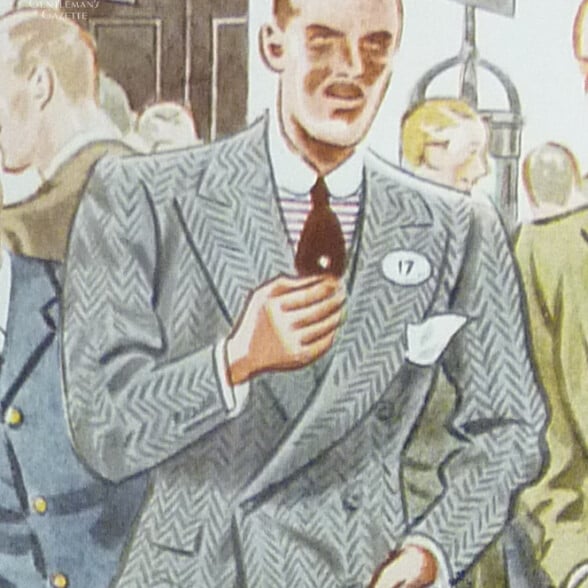
The rare horizontal striped shirt
Horizontal stripes were historically very common in menswear, but on shirts, they largely disappeared after the 1920s. Occasionally, however, you can find examples, such as this shirt from 1935, and also a shirt worn by Gordon Gecko in the 1987 film Wall Street.
Our Guide to Stripes in Menswear
Checkered
Shirts with checks are the most casual of the common dress shirts. Checks can come in a variety of densities and colors and can range from nearly invisible checks to blatantly bold checks. Because a dress shirt constitutes a large portion of your visual bulk, balancing a checked dress shirt with other garments like a jacket or tie requires a nuanced grasp of the rules of menswear.
Our Guide to Checks in Menswear
Weaves
The weave of a dress shirt refers to how its fibers were woven. At its most basic level, weave determines how breathable a fabric is: a denser weave is less breathable while a looser weave is more breathable, and so the former is generally better suited to colder climates and the latter to warmer.
Weave also determines how the fabric's surface appears and thus impacts the appearance of your dress shirt.
The topic of weave is covered in-depth in our Material & Fabric Guide, but a summation of basic information can be found below.
| Weave | Notes |
|---|---|
| Plain Weave | Consisting of a simple over-and-under pattern that can be easily recognized, the plain weave is very common and breathable but wrinkles easily. |
| Fil à fil | Regarding functionality, fil à fil, or end-on-end, is essentially identical to plain weave. Its sole difference is that fil à fil has either a warp or a weft yarn in a different color, creating a subtle, aesthetically pleasing tone shift. |
| Voile | In the voile weave, the warp and weft yarns are spun until they create a curly twist. This creates a wider thread, which produces an airy and soft fabric. Voile is one of the most lightweight weaves and is in many chases sheer, making it one of the coolest shirt fabrics, but also one of the most delicate. |
| Poplin | Sometimes referred to as broadcloth in North America, poplin is a thick fabric with a plain weave that features crosswise vertical warp and horizontal weft, giving it a unique corded appearance. Cotton poplin is favored for warm-weather shirts, especially when made from mercerized, or chemically treated for added softness, cotton. Poplin wrinkles easily but is otherwise very durable. |
| Twill | This weave is distinguished by a diagonal line that is created by similarly diagonal floats. It does not wrinkle very easily and maintains a smooth surface well. Twill has a higher yarn count than many other weaves and thus tends to be more expensive. Twill can be woven in a variety of patterns, the most famous of which include herringbone, houndstooth, and gabardine. |
| Oxford | Also known as Panana, this weave is traditionally associated with cotton shirts. It is very similar to plain weave but some of the warp or weft yarns are taken together, resulting in a wider, more basket-like weave. Because the weave imparts a lustrous look to the fabric, the oxford weave is favored for more formal shirts but is also used for casual shirts. Common varieties include Pinpoint Oxford, with its titular dot effect, and Royal Oxford, known for its shiny appearance. |
What are the 10 dress shirts all men should own?
Properly Utilizing the Functional Details: Buttons, Pockets, and Plackets
Buttons
Most dress shirts feature buttons along their front closure, and many have buttons at the cuff as part of a barrel cuff or collar as part of the button-down collar.
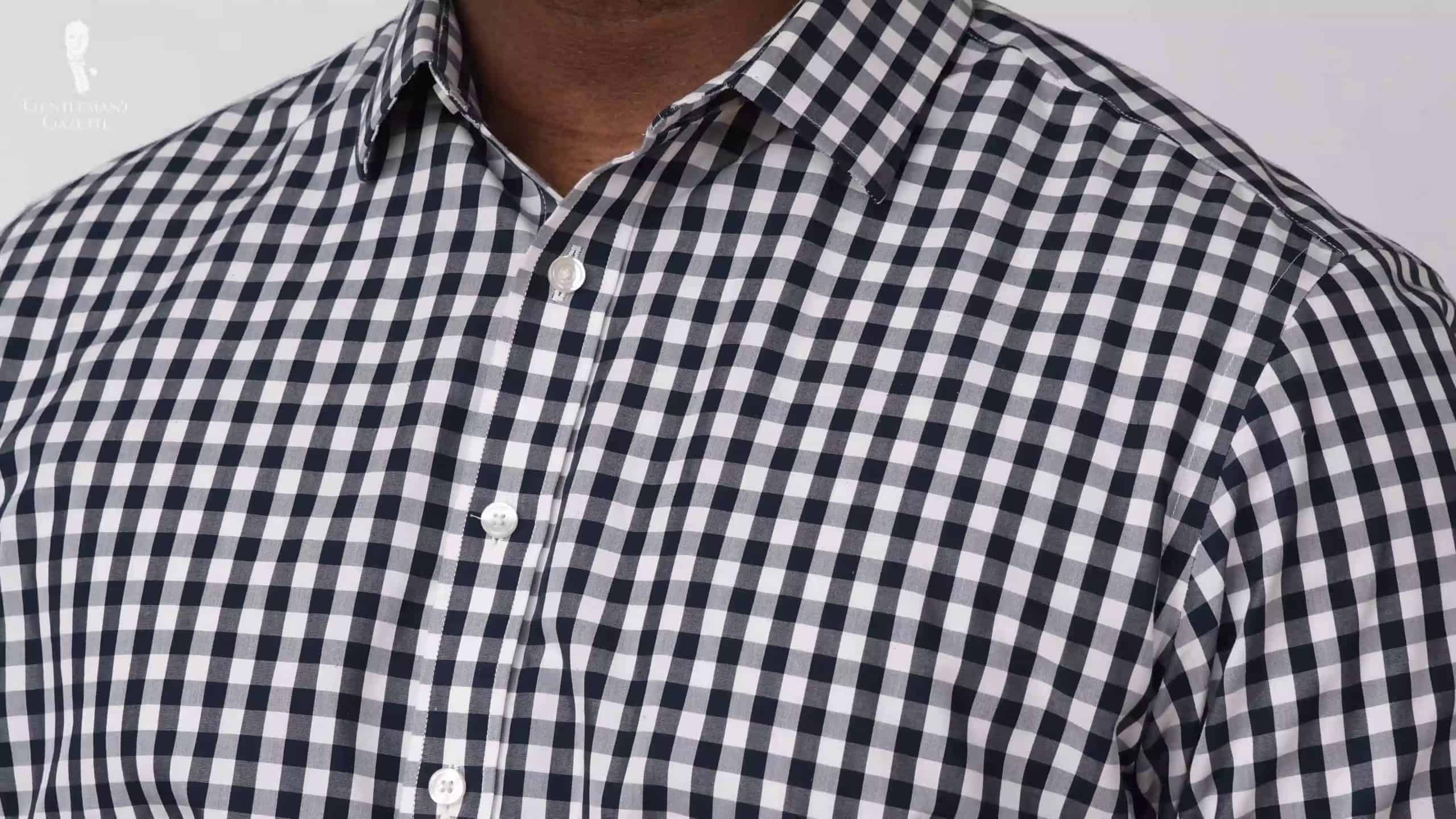
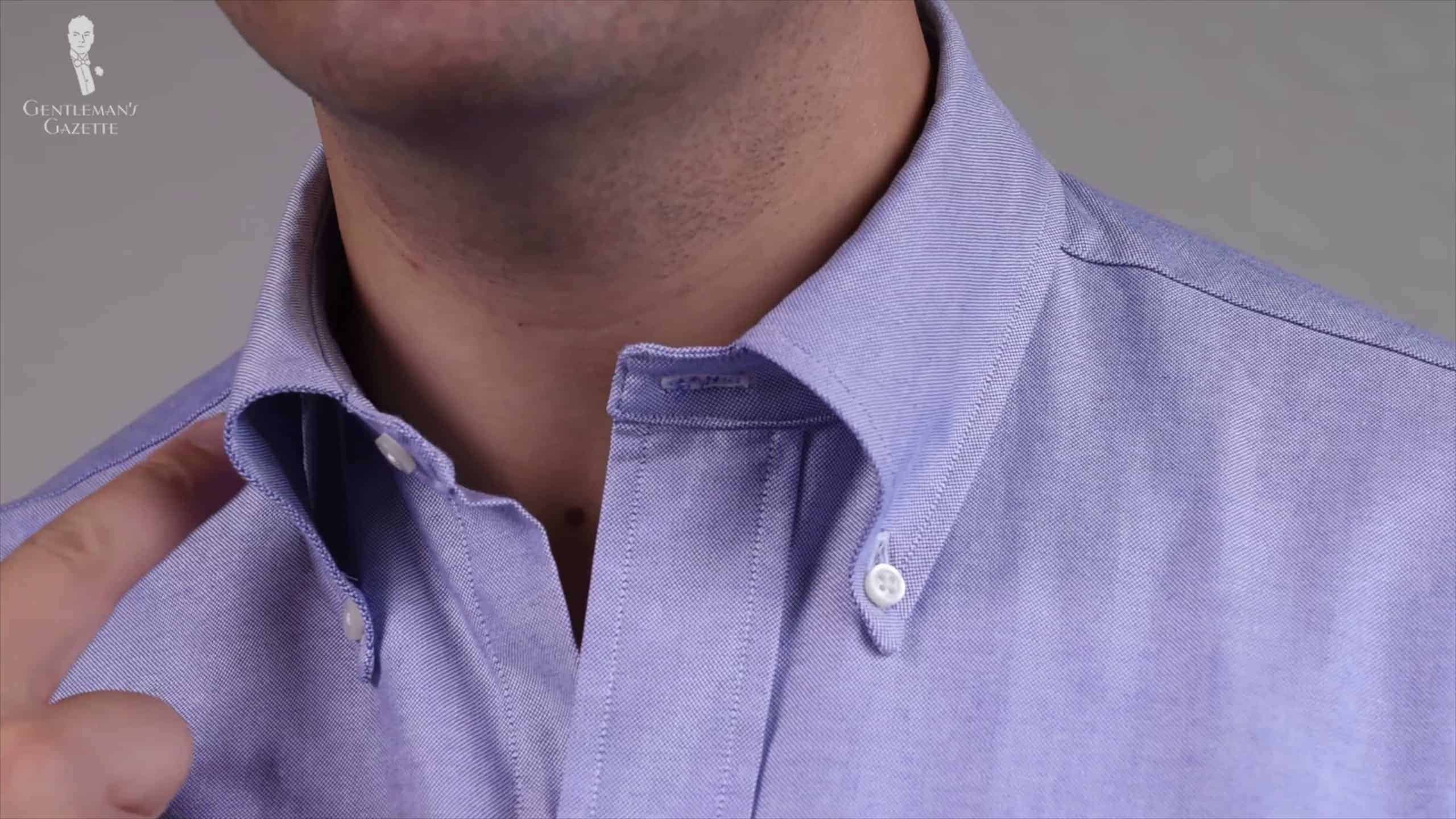
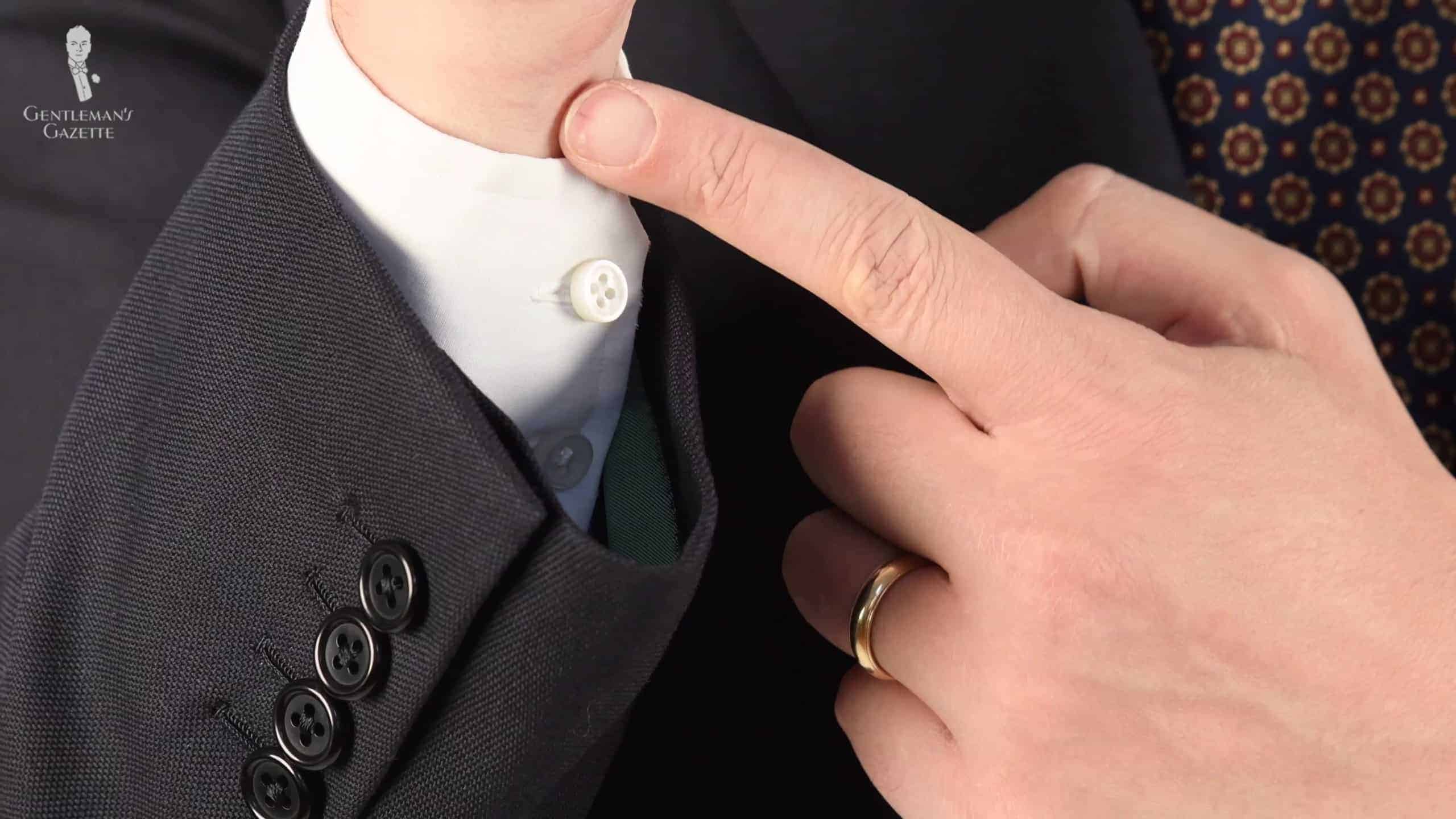
While the functionality of a button is of the greatest practical concern, the appearance of buttons has a major impact on the overall appearance of the dress shirt.
- The most formal buttons will be made from mother-of-pearl or bone and be white, beige, or black in color.
- Cheaper buttons will be made from plastic or other synthetics.
- Buttons that feature unusual colors or textures will generally be considered more casual.
- Buttons can also be stitched to shirts in unique and interesting ways, such as a cross-stitch or arrow-stitch, and can have matching or contrast thread for a more bold appearance.
How to Distinguish mother-of-pearl from Plastic
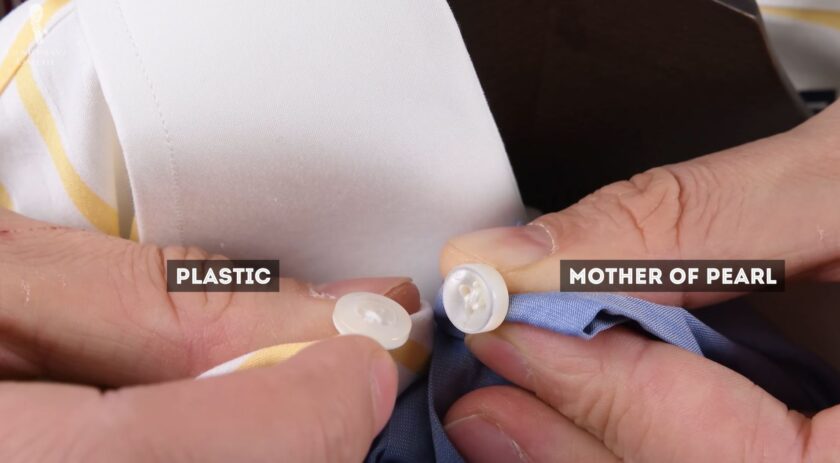
Well-made plastic buttons may be difficult to distinguish from mother-of-pearl visually. Therefore, you can employ one of two methods to ascertain the material of your buttons.
THE TAP TEST
Tap the buttons against a thin metal object like a pin, or against your teeth. Plastic produces a dull, low-pitched sound, while pearl will sound sharper and higher pitched.
THE TOUCH TEST
Place the buttons against a sensitive part of your body, such as your lips or cheek. If they feel cool, they are likely mother-of-pearl, while plastic buttons will feel warm.
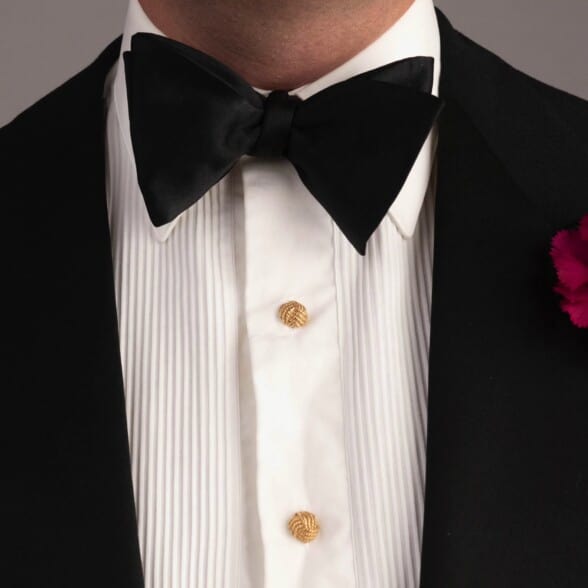
Some semantics on
Studs
Many formal shirts lack buttons on their fronts and are designed to be worn with studs, a unique piece of jewelry used to hold the shirt closed. Studs can be fashioned from a variety of materials, but the most classic will be made from silver, gold, platinum, onxy, or pearl.
Pockets

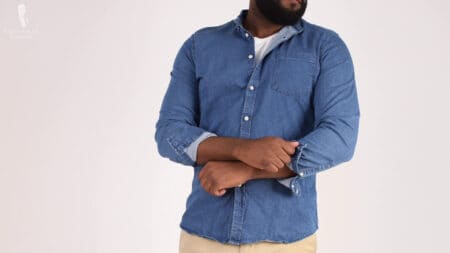
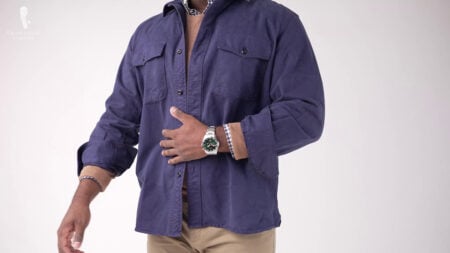
Because dress shirts were traditionally worn with a jacket, it was relatively uncommon for traditional dress shirts to feature any pockets. The exceptions were dress shirts worn during the day, in which case one breast pocket was occasionally featured to provide temporary storage.
| Number of Pockets | Notes | Formality |
|---|---|---|
| No Pockets | Typical of most traditional dress shirts and all formal dress shirts. | Formal |
| One Pocket | Typical of day dress shirts, renders the entire shirt more informal but still formal enough for many professional or social settings. | Informal |
| Two or More Pockets | Typical of a casual shirt, especially a sports shirt, work shirt, or recreational shirt. | Casual |
Yoke
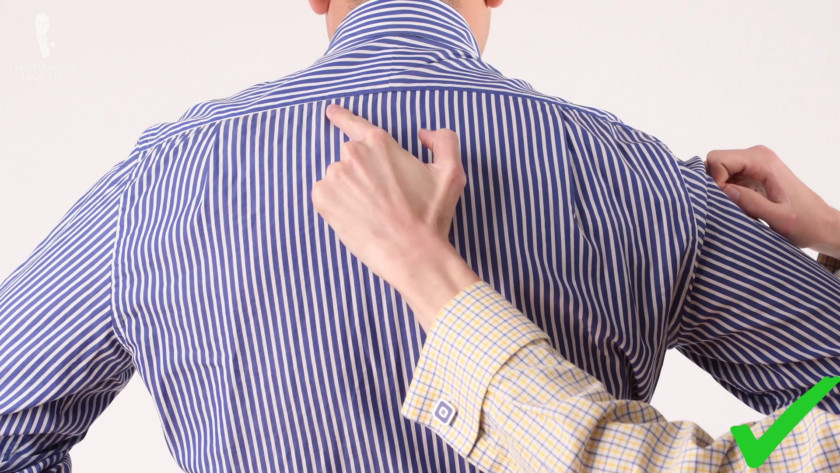
The yoke is the segment of dress shirt fabric that sits over the shoulders. It is cut separately from the rest of the shirt to allow for improved movement and drape.
Most off-the-rack yokes are made of one panel of fabric because it is cheaper for the manufacturer. There are, however, many benefits to a split-piece yoke made from two pieces of fabric. Each side of the split-piece yoke can be tailored to the actual dimensions of the body, compensating for anatomical variations like uneven shoulders.
This tailoring allows the yoke to sit more naturally on the shoulders, creating a more pleasing drape and helping to align any patterns on the shoulder sleeve seam. Of course, split-piece yokes require more work and measurements and will increase the shirt's overall price.
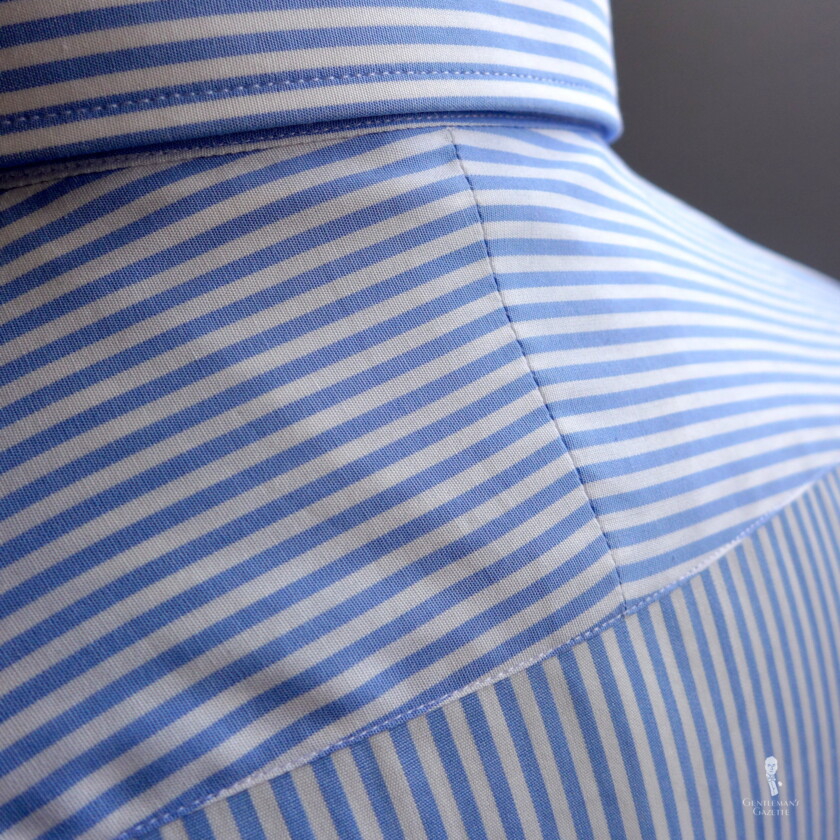
Plackets
The placket refers to the detailing around the button or stud closure along the front of the shirt. The placket is one of the main elements of the shirt's front because it automatically draws attention to itself due to its central position. Traditional dress shirts have a full placket that extends from collar to hem. Relaxed options such as a ¾ placket are reserved for more casual shirts.
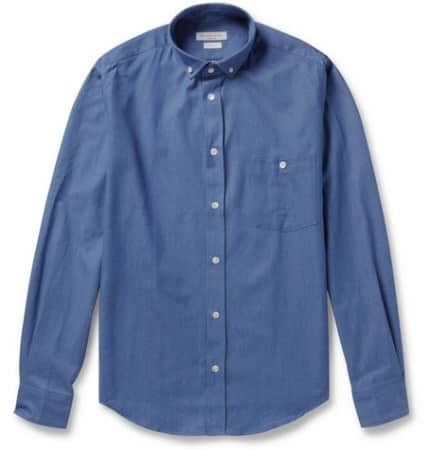
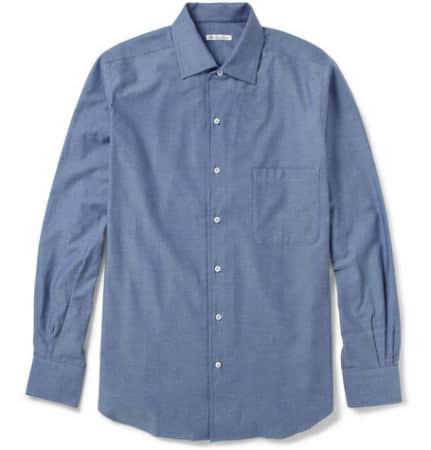
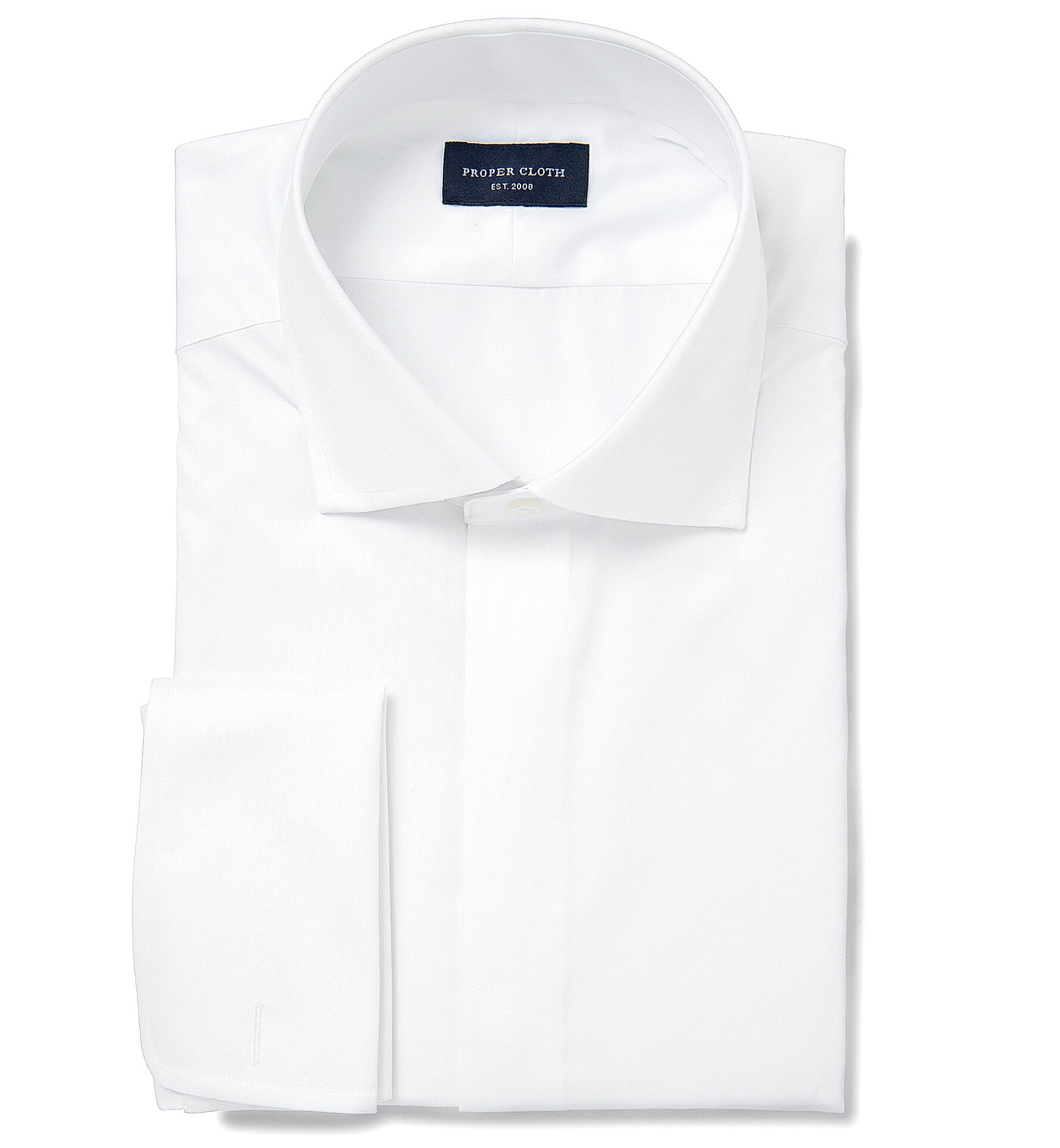
Traditional
Also known as the "American placket" due to the strong influence and representation of American style, this is the most conventional style of all. It adds symmetry to a dress shirt, and it is basically a separate piece of fabric attached to the shirt front. It can either be folded or stitched, and it is a popular option for everyday business shirts, but you can also find them on traditional American Oxford Cloth Button Down shirts.
French
The French placket is a more polished alternative than the traditional placket, and therefore it is the choice for evening shirts. It is a very simplistic style that is achieved by folding the fabric over itself inwards. This technique results in a clean shirt front without any stitching. As the name implies, it is associated with a European aesthetic and is the go-to choice for a more modern debonair look. Although traditionally more formal, the French placket can be worn with classic, fashion, or casual shirts today.
Fly-Front
Originally the fly front placket was a modern take on an evening shirt placket without any shirt studs. It features an extra flap of fabric which conceals the buttons thus providing a cleaner looking shirt. At the end of the day, it is still a poor man's alternative to an evening shirt, and even though some fashion brands have utilized this placket in regular dress shirts, you better stay clear of it, if you want a timeless shirt wardrobe.
Darts
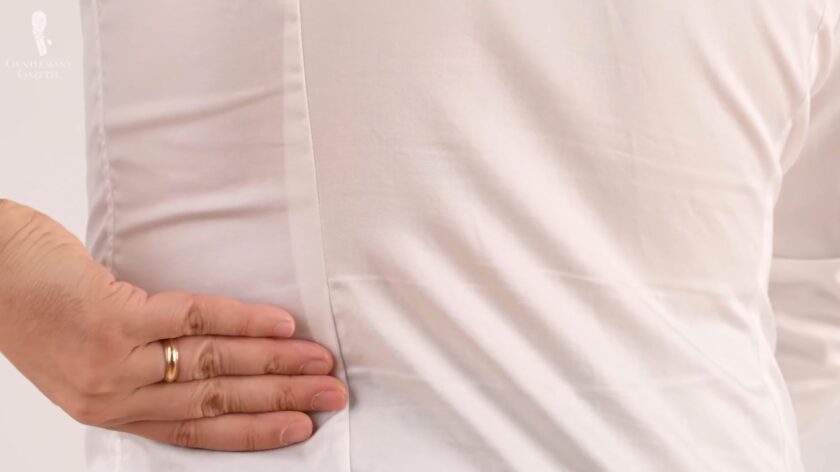
Darts are folds sewn into the dress shirt to minimize excess fabric and to help provide localized shape to the garment. They can appear on the back or the front of the dress shirt, and depending on their relative width, can be very noticeable. Darts are primarily employed in dress shirts to cinch the waist and give the entire shirt a more slim appearance, and as such, they are most often seen on dress shirts with more modern styling.
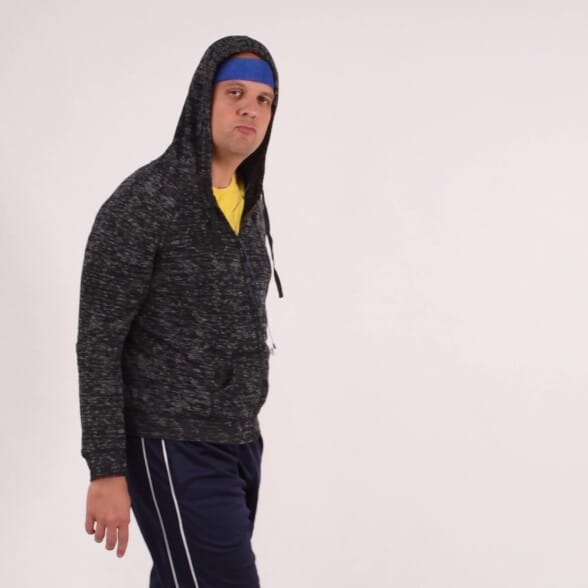
Hourglass shape or athletic build?
Consider Darts!
For men with very athletic builds, such as broad shoulders and hips with a trim natural waist, dress shirts often puddle around the middle because of excess fabric. Darts can be an excellent solution to this problem, allowing for a trim silhouette that is tight at the waist without constricting the hips and shoulders.
Pleats
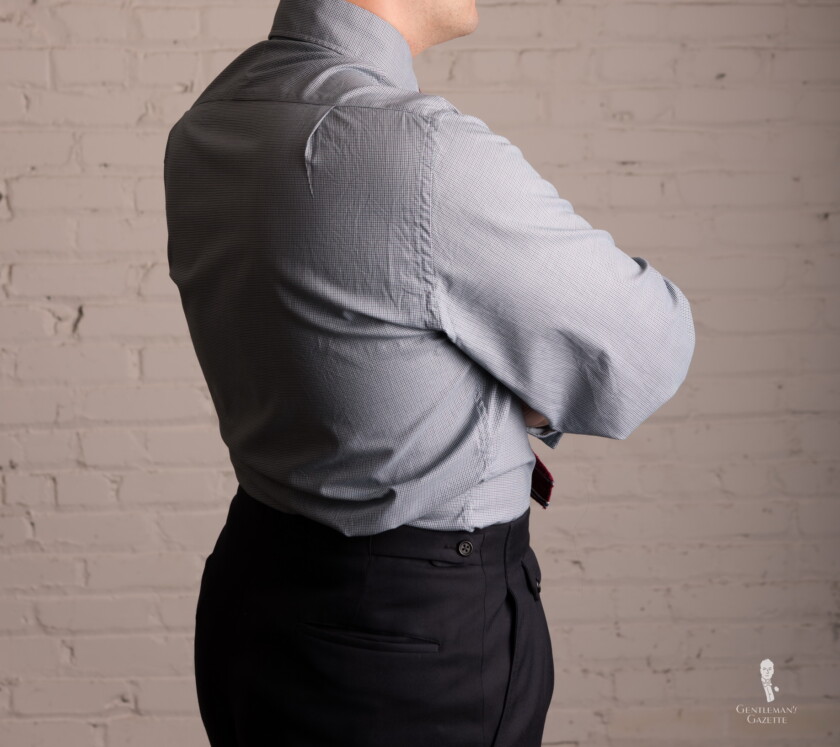
Pleats are gatherings of excess fabric that help provide a greater range of movement and generally improve comfort. Although traditionally seen on trousers, shoulder or back pleats on shirts help to guarantee a large range of movement in your arms, and they cause minimal disruption to the overall appearance of the shirt.
Determining Which Collar Type Works for You
The collar is arguably the core of the shirt as it is the most visible element of the garment. Chosen correctly, it should enhance your face and your look. While you can design a collar of your choice with bespoke shirts, even the off-the-rack and made-to-measure industry offers hundreds of different collar shapes.
Collar shapes have variable formalities and harmonize with different face shapes to greater or lesser degrees. The size of your tie and tie knot can also significantly impact the appropriateness of a particular collar type.
As with fit, naming conventions are not standardized, so what constitutes a "classic point collar" can vary from manufacturer to manufacturer.
Classic Collars
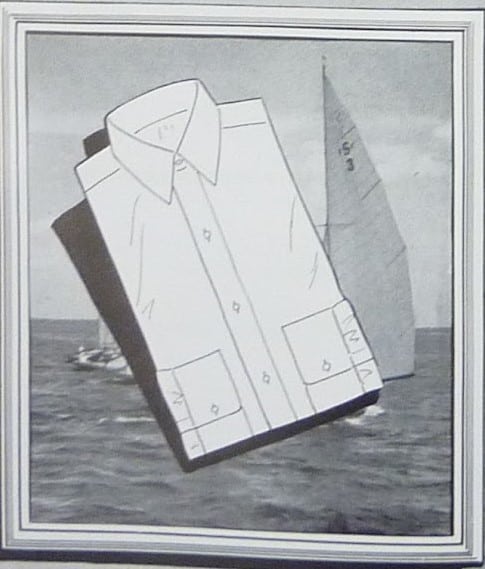
Classic Point Collar
A classic collar is the timeless pointed collar that is "just right." It avoids all extremes in that it is neither too large, nor too small, nor is it too spread or too narrow. It offers the ideal tie gap for small- to mid-size tie knots, and it is a timeless and necessary part of every Classic wardrobe.
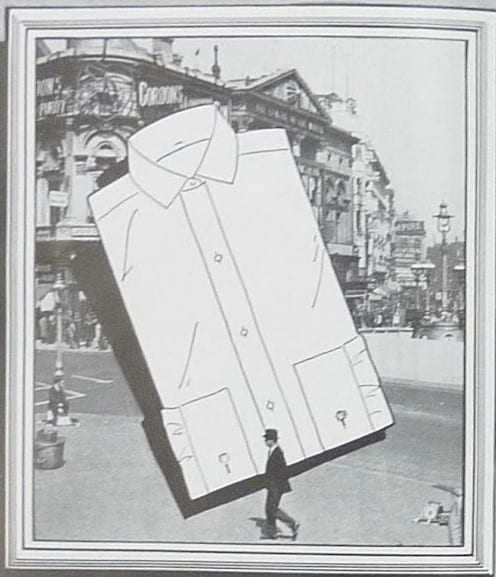
Spread Collar
A spread collar is by far the most popular contemporary model and a go-to choice for both casual and classic shirts. The beauty of it relies in the versatility, working perfectly with or without a tie, though when you do wear a tie it's crucial to pick the right size knot to fit the wider gap.
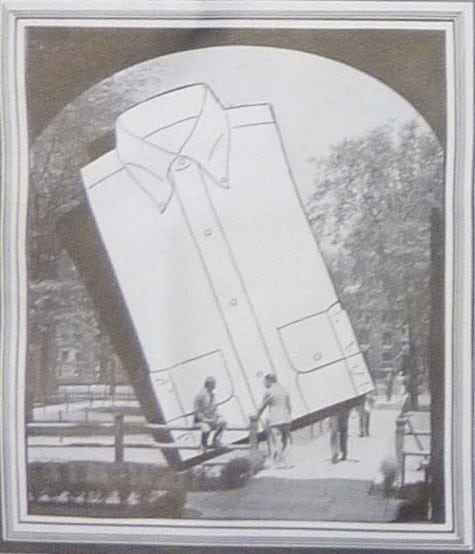
Button-Down Collar
A button-down collar is an American, casual-cool classic shirt that we've written extensively about in our Oxford Cloth Button-Down guide. It is very commonly seen on Oxford shirts.
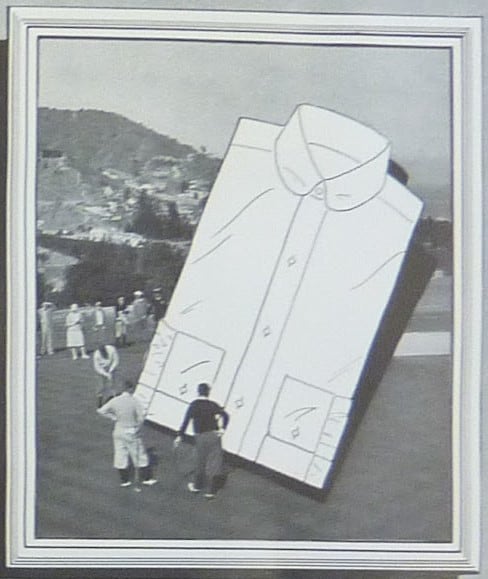
Club Collar
A club collar is a historic collar that was recently revived by period television series like Mad Men and Boardwalk Empire. A different spread can create a very different look and they tend to look especially exquisitve with a collar clip or bar.
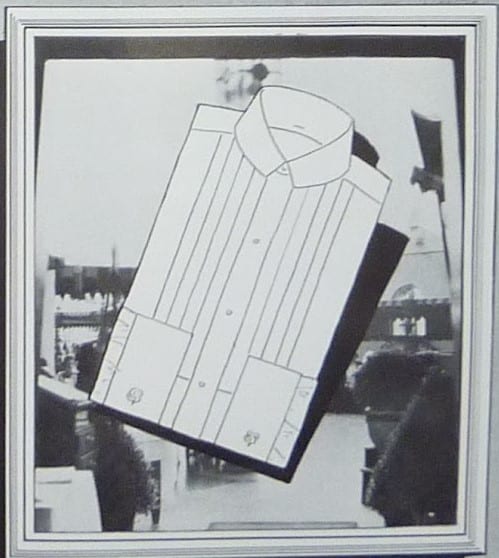
Evening Collar
An evening collar was traditionally detachable, starched, and stiff. Today, most tuxedo shirts feature an attached wing collar that is often too small and lank. Therefore, you will be best served wearing a turn-down collar with your tuxedo or a real detachable collar. For white tie, only wear a detachable collar.
Contemporary Collars
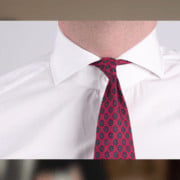
Cutaway Collar
A cutaway collar is a modern approach to the spread collar, this model seamlessly works with a variety of shirts from denim to oxfords and even contemporary classics, but it is often difficult to wear it with a tie or bow tie. If you like this look, it's best to wear it without neckwear.
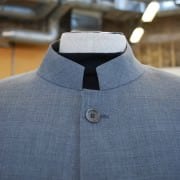
Stand-Up Collar
Also known as a Mao collar, this collar came to prominence in Western menswear in the 1960s and has enjoyed occasional revivals. Most often associated with conductors or artists and paired with a Nehrun jacket, it is a bold and distinct styling option.
Picking the Correct Cuffs
Cuffs refer to the termination of the sleeve where your wrist connects to your hand. Shirt cuffs come in two varieties, defined by their closure method.
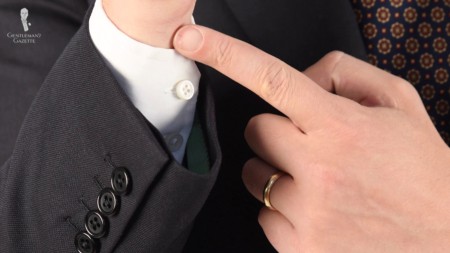
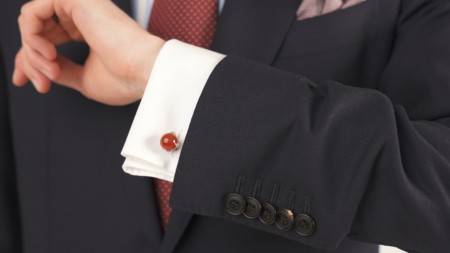
Barrel Cuffs
Barrel cuffs, often referred to as button cuffs, are the everyday choice for most men and the most commonly found cuff type. With a variety of shapes and designs and number of buttons, barrel cuffs provide a wide range of choices to the wearer and are very practical. One critical aspect to bear in mind when considering the type of cuff to choose is its height: traditional, and effectively, outdated cuffs usually sit between 7.5 and 8 centimeters, whereas contemporary classic cuffs are about 6 centimeters, and anything less is on the more fashionable side.
French Cuffs
Traditionally, French cuffs are dressier and more formal, allowing men to sport one of the quintessential pieces of jewelry in men's style: cufflinks. Because this accessory makes a personal statement and expresses the wearer's style, French cuffs have become quite popular in recent years, and they are not just reserved for formal shirts.
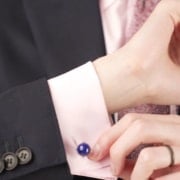
Eagle Claw Cufflinks with Lapis Lazuli Balls
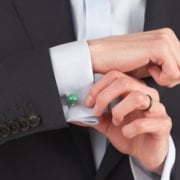
Eagle Claw Cufflinks with Malachite Balls
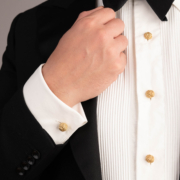
Gold Monkey Fist Cufflinks & Matching Studs
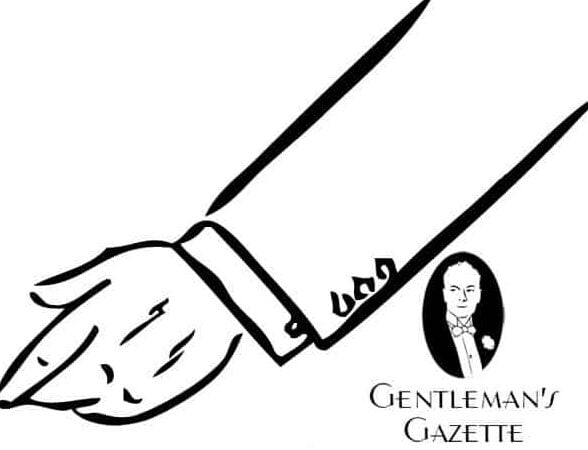
Finding the perfect
Sleeve Length
If you wear a lot of jackets with shirts from different manufacturers or tailors, you'll notice that the shirt sleeve length and the amount of cuff you show varies depending on the cut of the armholes of the shirt and the jacket. To prevent that, you can have 6 or 8 buttonholes instead of the usual 4 on a French cuff, so you can easily adjust the shirt length to the jacket. In England, they sometimes come with 6 buttonholes by default and it can be a very useful feature indeed.
The Impact of the Hem: To Tuck or Not To Tuck
The hem refers to the lower edge of the dress shirt, and can include a tail if a portion of the hem extends doawns. The bottom hem indicates a great deal about a shirt's style, namely if it leans toward the more classic or relaxed end of the spectrum.
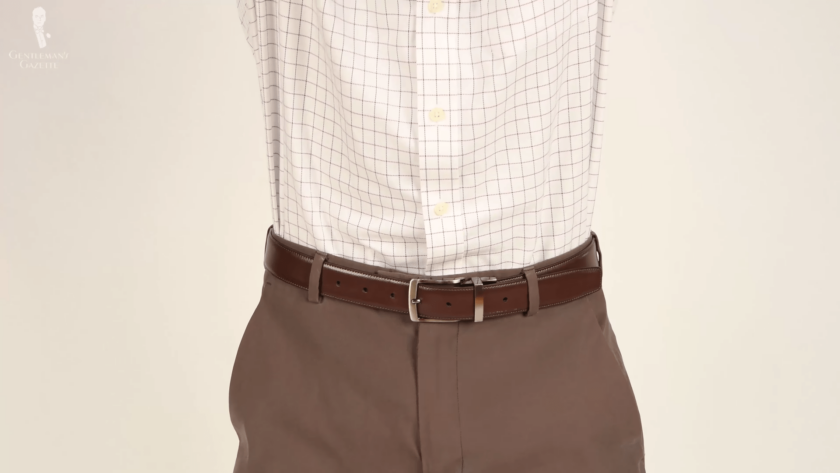
Classic
A classic dress shirt is worn tucked in. Therefore the tail and front hems are longer than the sides, so it doesn't come untucked during the day. Unfortunately, many off-the-rack shirts today are cut shorter because it helps to reduce the amount of fabric used. Although tails have gotten shorter in recent years, the design must still ensure the functional aspect, which makes the ratio between the lower and higher ends of the tail a critical variable.
Straight
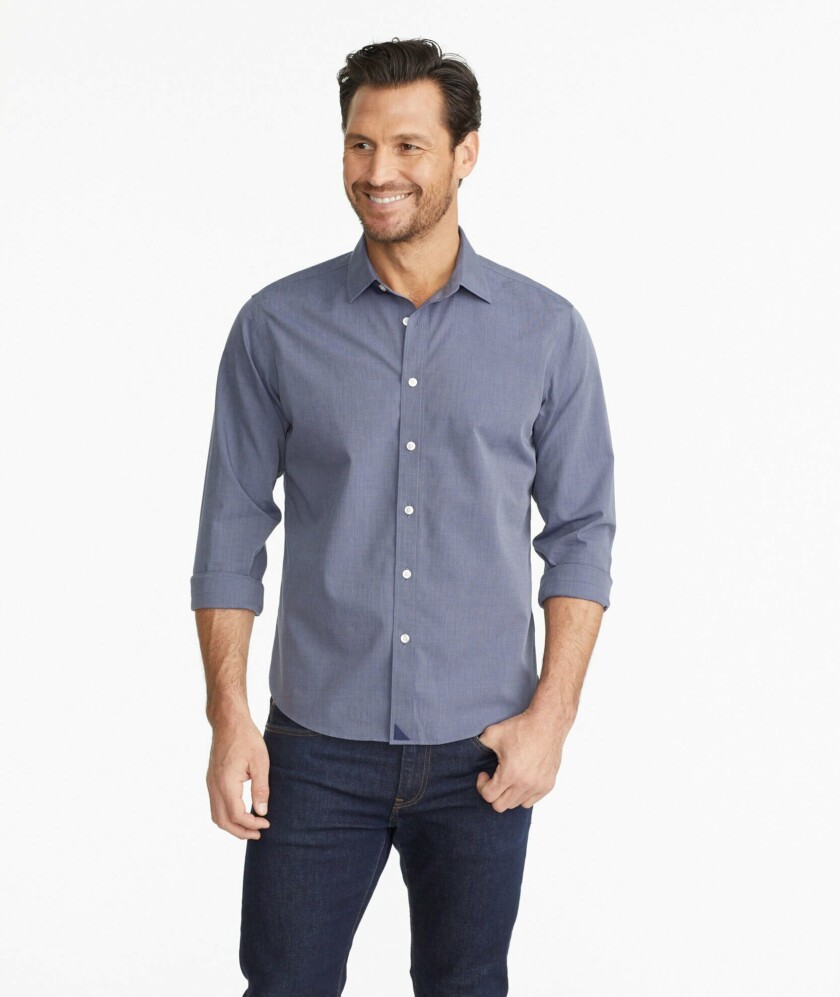
If you are looking for a casual shirt that you can wear untucked on a more relaxed occasion, straight hems are the way to go. Unlike the tail-shaped version, straight hems make the shirt much more prone to becoming untucked on its own as a result of natural body movements, so caution is advised when choosing the length: too short will look disproportional, whereas too long will just look ridiculous if worn untucked.
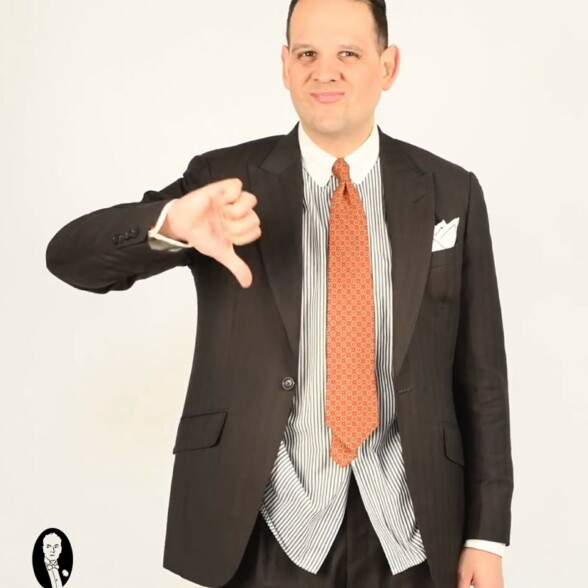
To tuck or not to tuck?
According to the conventions of Classic Style, all dress shirts should be tucked in, and only short-hemmed sports shirts should be worn untucked. Dress shirts are intentionally cut with a longer tail to help hold the shirt in place, and this hem can look awkward when not neatly tucked into trousers.
Selecting the Perfect Decorative Details
Stitch Density & Distance
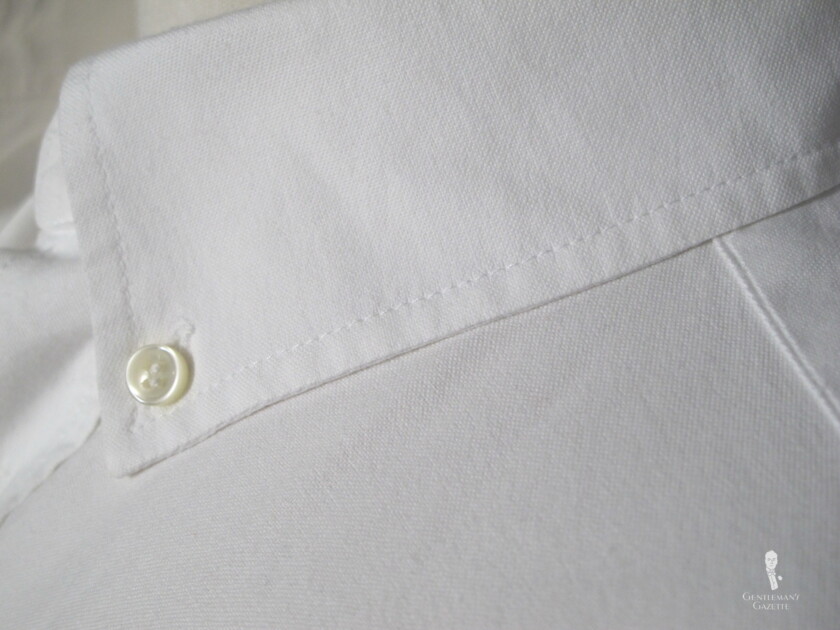
Stitch density refers to the number of stitches that are sewn within a discreet distance, usually within one inch. A higher stitch density generally produces a tighter hold and is also more aesthetically pleasing. You will usually only be able to dictate stitch density when having a bespoke shirt made.
Stitch distance refers to how far the stitch is sewn from the edge of the fabric. Generally, the closer to the edge, the more formal the stitch and shirt will appear.
Monograms

Monograms were originally stitched onto gentlemen's shirts to make them easy to distinguish in the laundry and were never intended for public view. Therefore, monograms were located on discreet areas of the shirt, such as the back of the collar, over the left breast or stomach, or on the tail.
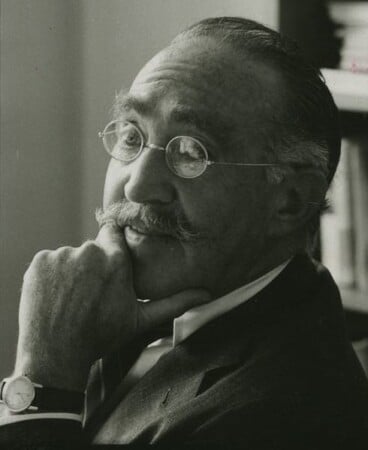
"Look at this shirt! Specially made for me by Thresher & Glenny in London – it cost more than you probably spent on coal last winter. If I told 'em once, I told 'em a hundred times – I want the monogram in Old English, not Roman type! What do they think I am – a letterhead?"
S.J. Perelman
Starting in the second half of the 20th century, some men wanted to broadcast their monograms and so decided to display them more prominently, usually on the cuff. Nowadays, the choice to have a monogram is entirely your own, but as in most things, the most Classic monogram will be discreet and understated.
Contrasting Elements
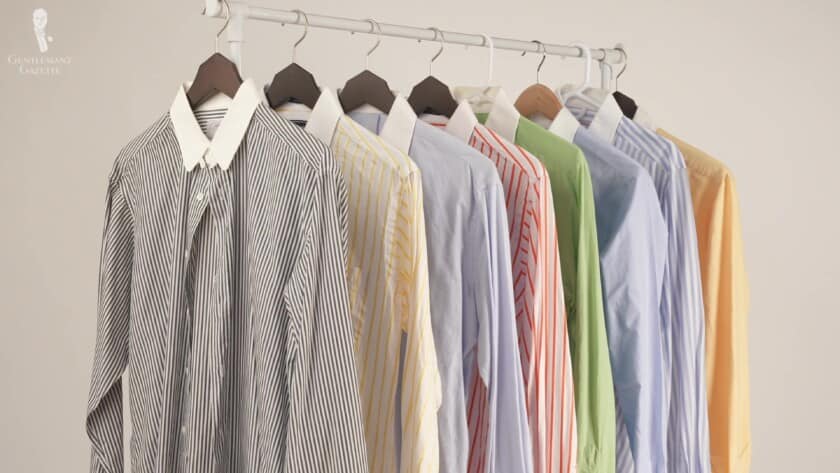
With the rise of online MTM shirts, many brands are offering men the opportunity to add contrasting stitching, collar undersides, shirt plackets, buttonholes or cuff linings to their bespoke shirts. Since most off-the-rack shirts do not have these loud customizations, it's become another way to show off one's bespoke clothing, much like working surgeon's cuffs were 10 years ago.
These details are flashy, so they should be used wisely and sparingly. They can elevate a casual shirt to a new standard, but the second you go overboard it will be too attention-grabbing. Contrasting elements work best when used with subtlety.
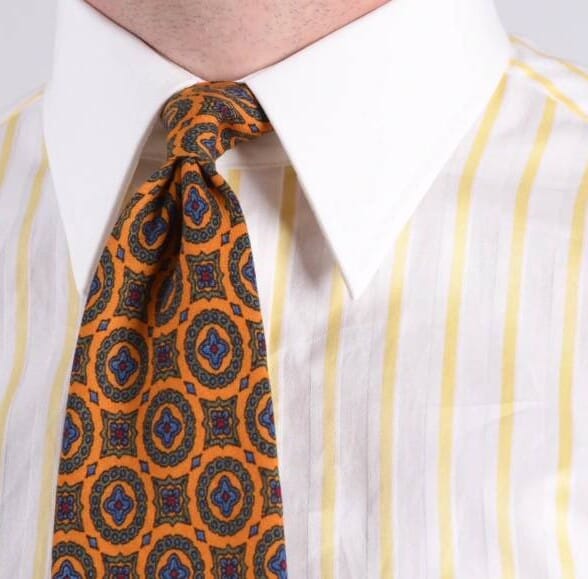
Classic Contrast
The Winchester Shirt
The Winchester shirt, with white cuffs and collar that contrast with the body of the shirt, is a genuine classic in menswear. The subtle contrast elevates a shirts formality and makes it more business appropriate. Avoid using other contrast colors or patterns together with this combination, as the look is strong enough on it's own.
Learn more about Winchester shirts!
Buying a Dress Shirt
How to Pick the Right Dress Shirt for You
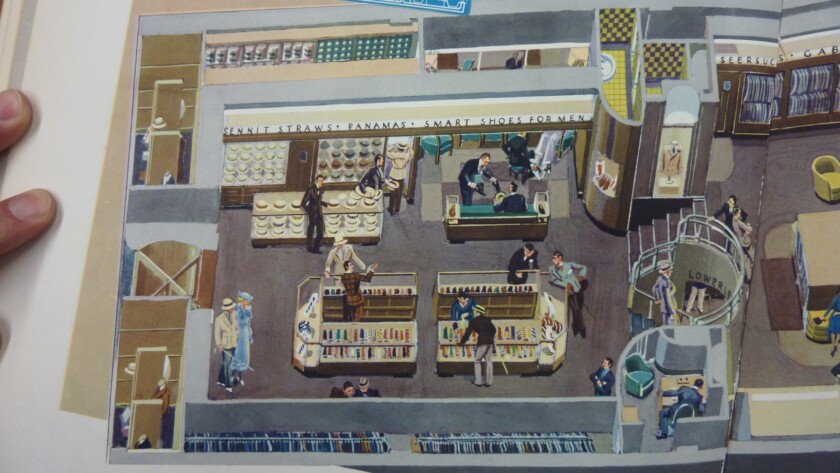
Along with your suits, a dress shirt will be one of the most important components of your ensemble and an item you will likely wear almost daily. To that end, it is beneficial for you to invest in a wide selection of versatile, well-made, and timeless shirts that will serve you well for years and satisfy all of your needs.
Hallmarks of Quality
When faced with a price differential of $30 compared to $300 for a dress shirt, you might feel daunted in selecting the more expensive option. Careful consideration of the construction, materials, and fine detailing of a well-made dress shirt, however, will make it clear that a higher quality shirt, even if purchased second-hand, will also offer a better cost-per-wear ratio than a cheap dress shirt.
Our Brand Reviews and Recommendations
From historic shirtmakers to modern fashion brands, nearly every manufacturer in menswear offers dress shirts. Finding a dependable brand will require a little experience and a lot of research, but do not fret, because the Gentleman's Gazette is here to help guide you every step of the way.
Need help starting a dress shirt collection? Check out these brands!
- Brooks Brothers
- Charles Tyrwhitt
- Eton
- Hawes & Curtis
- Pini Parma
Ready to take the next step? Consider made-to-measure or bespoke!
- Apposta
- Turnbull & Asser
- Budd Shirtmakers
- Simone Abbarchi
- Charvet
Learn the 13 most over-and-underrated dress shirts!
Learning the Basics of Dress Shirt Care
Protect Your Investment with Regular and Attentive Care
If you are going to invest in a well-made dress shirt, you should ensure that this dress shirt will last for as long as possible. This will require not only keeping it clean and mended but doing so in a way that prolongs the life of the dress shirt.
Dress shirt care will vary considerably based on the material of the shirt. Therefore, before washing any dress shirt, consult and understand the washing instructions located on the tag at the collar or on the interior seam of the body.

How Often To Wash
Whether you wear an undershirt or not, portions of your dress shirt, primarily at the collar and cuffs, will come into contact with your skin. This contact will expose the fabric to sweat, oils, and other elements that can stain your dress shirt. Therefore, especially if you have sweated considerably, it is advisable to wash your dress shirts, especially white dress shirts, after every wear.

Excessive washing, however, can expose your dress shirts to increased wear, especially if the shirt is made from delicate fabric. Therefore, you should always wash your shirts on the most gentle cycle that still ensures they are thoroughly cleaned and limit, or avoid entirely, the use of dryers, because they pummel your clothes during the drying process.
Ironing
It is often considered an onerous and unpleasant task to iron a dress shirt, but when done properly and in an efficient manner, ironing a shirt, just like ironing any garment, is a simple and easy-to-do task that will ensure that your dress shirt looks its very best.
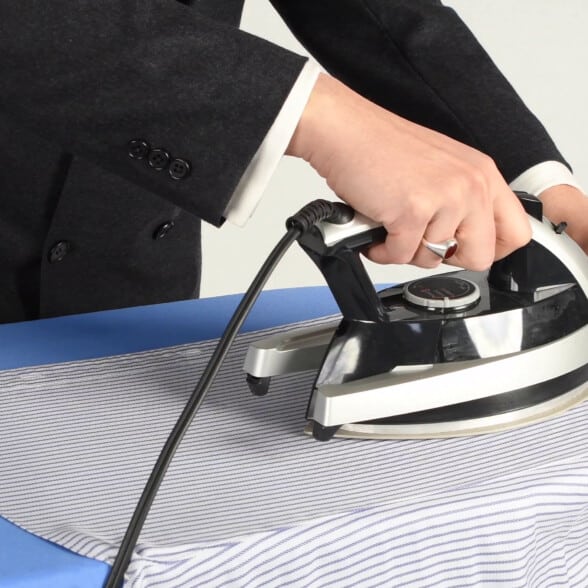
Be wary of non-iron shirts
While it is advisable to keep a few non-iron dress shirts on hand for when you are traveling, you will be best served generally avoiding non-iron shirts. This is because non-iron fabrics have been treated with chemicals that make the shirt stuffier and less breathable, and some men even have allergic reactions to them. The majority of your dress shirts should not be coated in non-iron finishes and should instead by ironed as needed.
Shrinkage
Cotton dress shirts are likely to shrink in the wash, especially if washed with very hot water. Shirtmakers will compensate for this decrease in size by pre-shrinking the shirt, treating it chemically to reduce shrinkage, or alloting extra fabric to account for shrinkage.
Conclusion
As you can see, the look and feel of a shirt are not just defined by your choice of fabric and the details alone but also heavily by the style choices you make.
We hope this article has left you feeling empowered to make all of the many important decisions that go into selecting the perfect dress shirt. Whether you choose a dress shirt that is off-the-rack, made-to-measure, or fully bespoke, we can't wait to see how good you look!
FAQ
What is a dress shirt?
A dress shirt is any shirt with a collar and full-length closure secured by buttons or studs that is more formal, usually in styling and material, than a sport or recreational shirt.
What are sport and recreational shirts?
A sport shirt is intended for casual wear, such as leisure or sporting activities. A recreational shirt is specifically designed for particular activities, such as hiking, hunting, or fishing.
What type of dress shirt is best?
Ultimately, the best dress shirt depends on how you intend to wear it. That being said, every gentleman interested in Classic style will benefit from having a plain weave white solid dress shirt with a point or spread collar and barrel or French cuffs in his wardrobe.
What is the best way to style a dress shirt?
Whether worn with slacks or jeans or with or without a jacket, the key to a great-looking dress shirt is always fit. Find a great fit, and your dress shirt will shine in any ensemble.
How are dress shirts sized?
Very inexpensive dress shirts are sized at intervals of "Small, Medium, and Large." Most dress shirts are sized according to the circumference of your neck and the length of your arm: e.g., 16 & 32.
What is the best fit for a dress shirt?
Ultimately, you are the final arbiter of how your dress shirt should fit. That being said, any fit that is distractingly tight or distractingly loose is not indicative of the Classic Style.
Can a dress shirt be altered?
Yes, a dress shirt can be altered, but these alterations are usually fairly expensive relative to the cost of the shirt. It is, therefore, easier to ensure that the fit is acceptable upon purchase or to invest in made-to-measure or bespoke shirts.
How long should dress shirt sleeves be?
Technically, sleeve length is a matter of personal preference, but most Classic stylists agree that the edge of your cuff should brush the root of your thumb at all times.
Do you have to tuck in dress shirts?
According to the conventions of Classic Style, most dress shirts ought to be worn tuck-in. An exception would be more casual dress shirts with a straight, shallow hem.
What is the best material for a dress shirt?
The majority of gentlemen will benefit from owning a dress shirt in light or medium-weight cotton. Gentlemen in warmer climates might wish to consider linen, while gentlemen in colder climates should consider heavier-weight cotton.
Will dress shirts shrink in the wash?
Depending upon the materials from which they are made and any special finishes, some dress shirts will shrink in the wash but, if washed properly, will only shrink down to the advertised size. Excessive shrinkage can occur, however, if a dress shirt is washed improperly.
What is the difference between a dress shirt and a formal shirt?
A formal shirt is technically a special type of dress shirt intended to be worn only at Black Tie or White Tie events. Somewhat confusingly, formal shirts are occasionally called "full-dress shirts."
alexanderbeepireed.blogspot.com
Source: https://www.gentlemansgazette.com/the-shirt-style-guide/
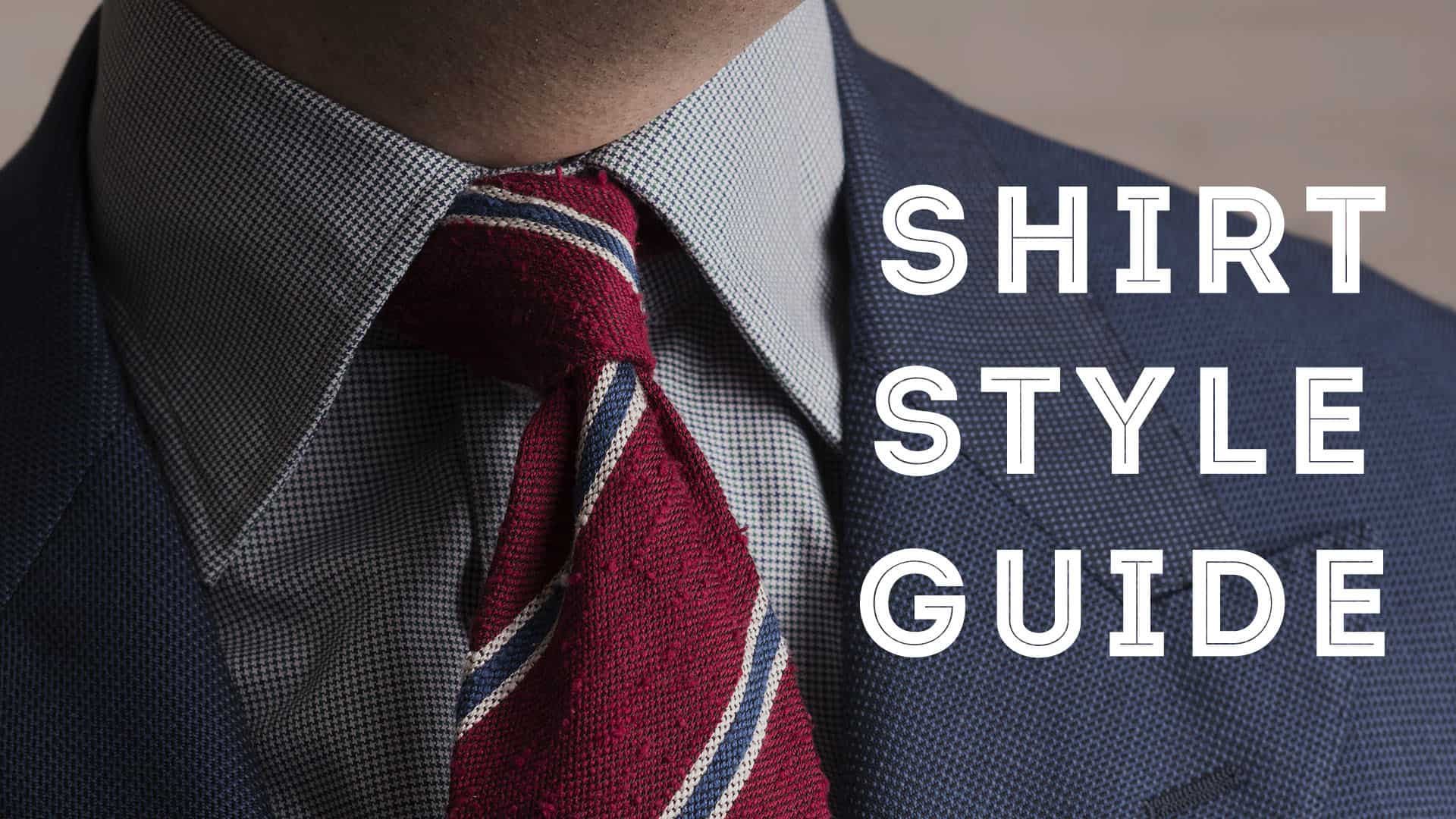
0 Response to "How to Wear a White Collar Dress Shirt"
Post a Comment